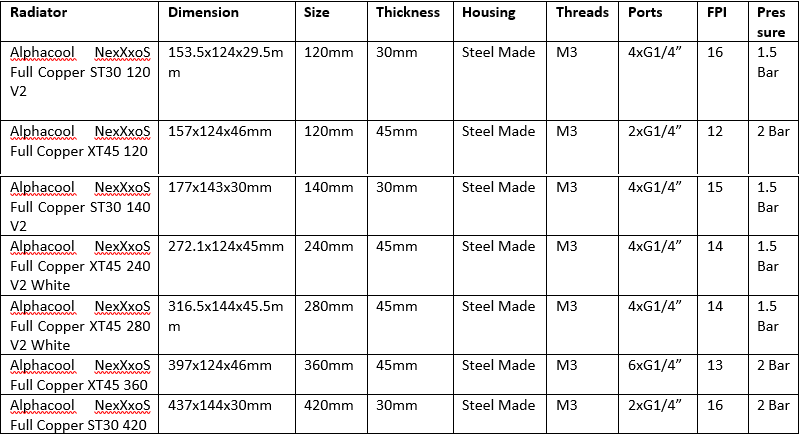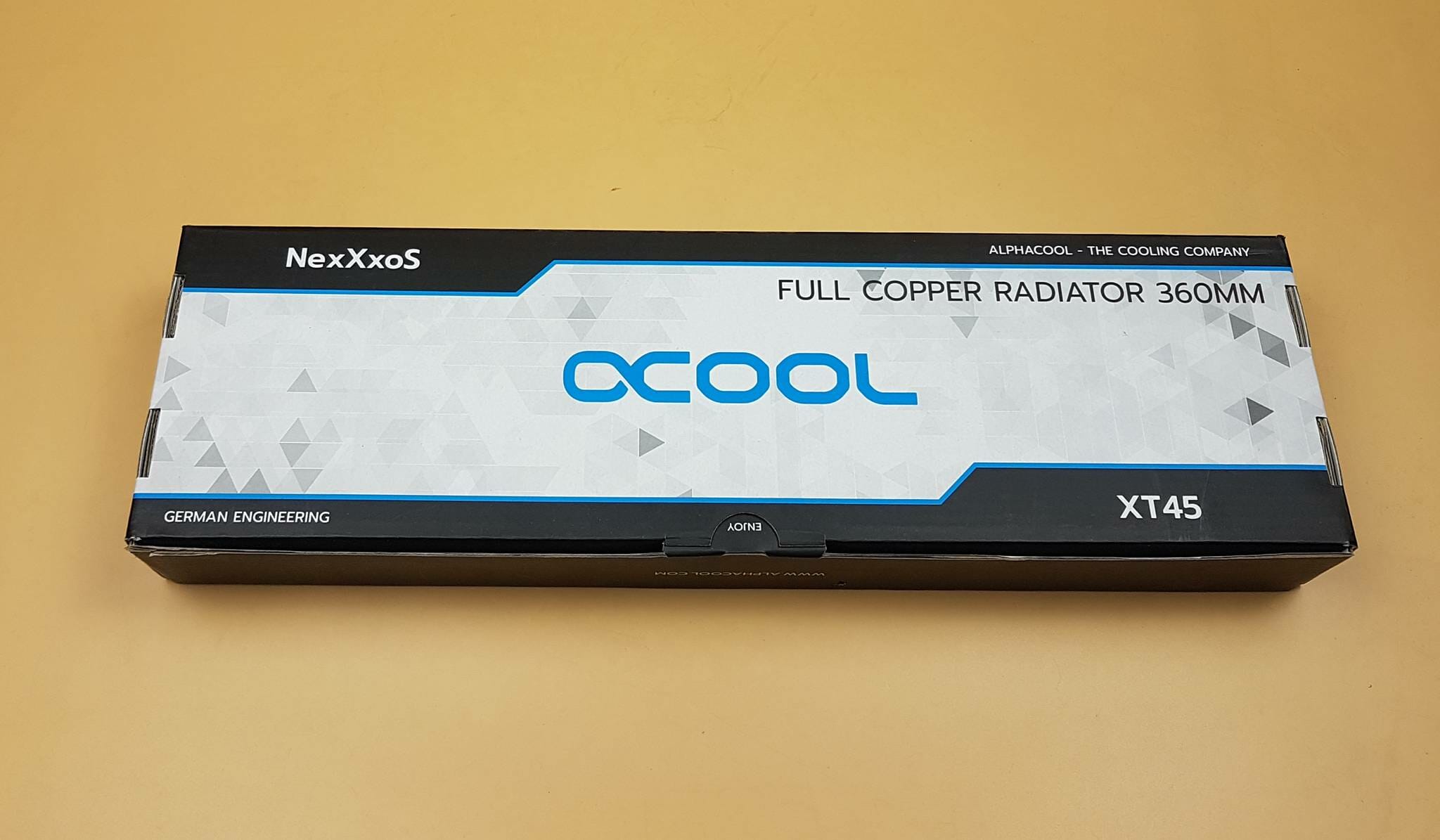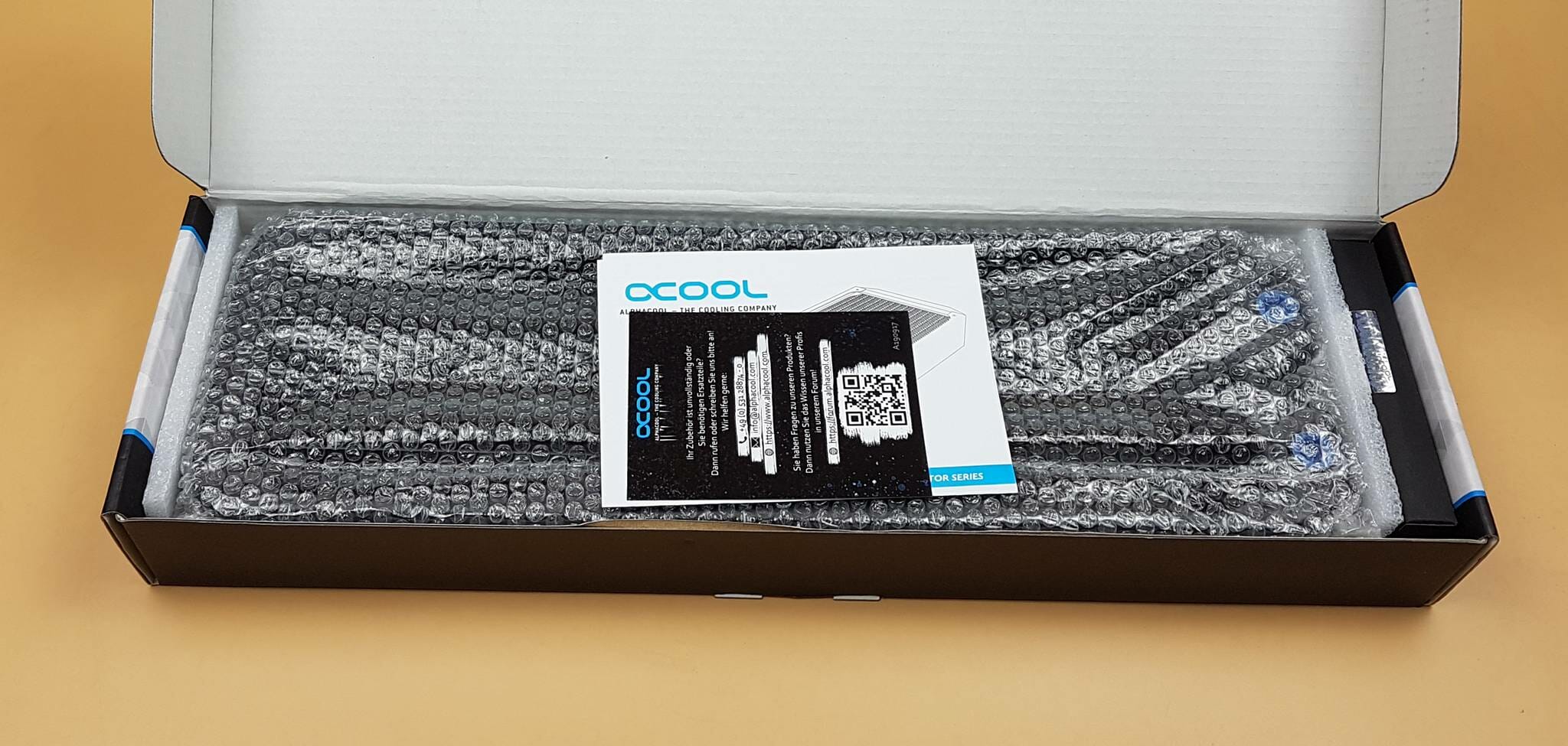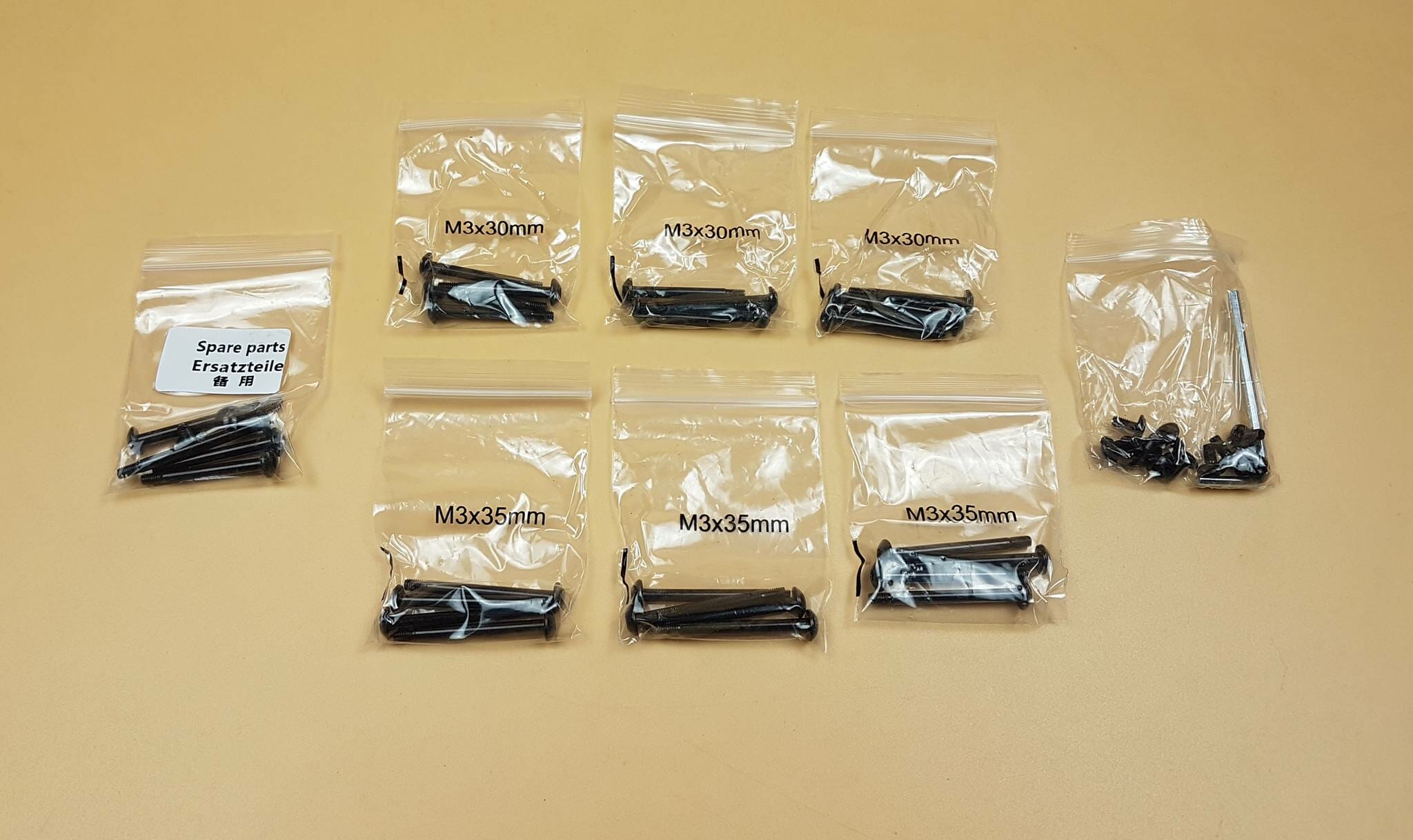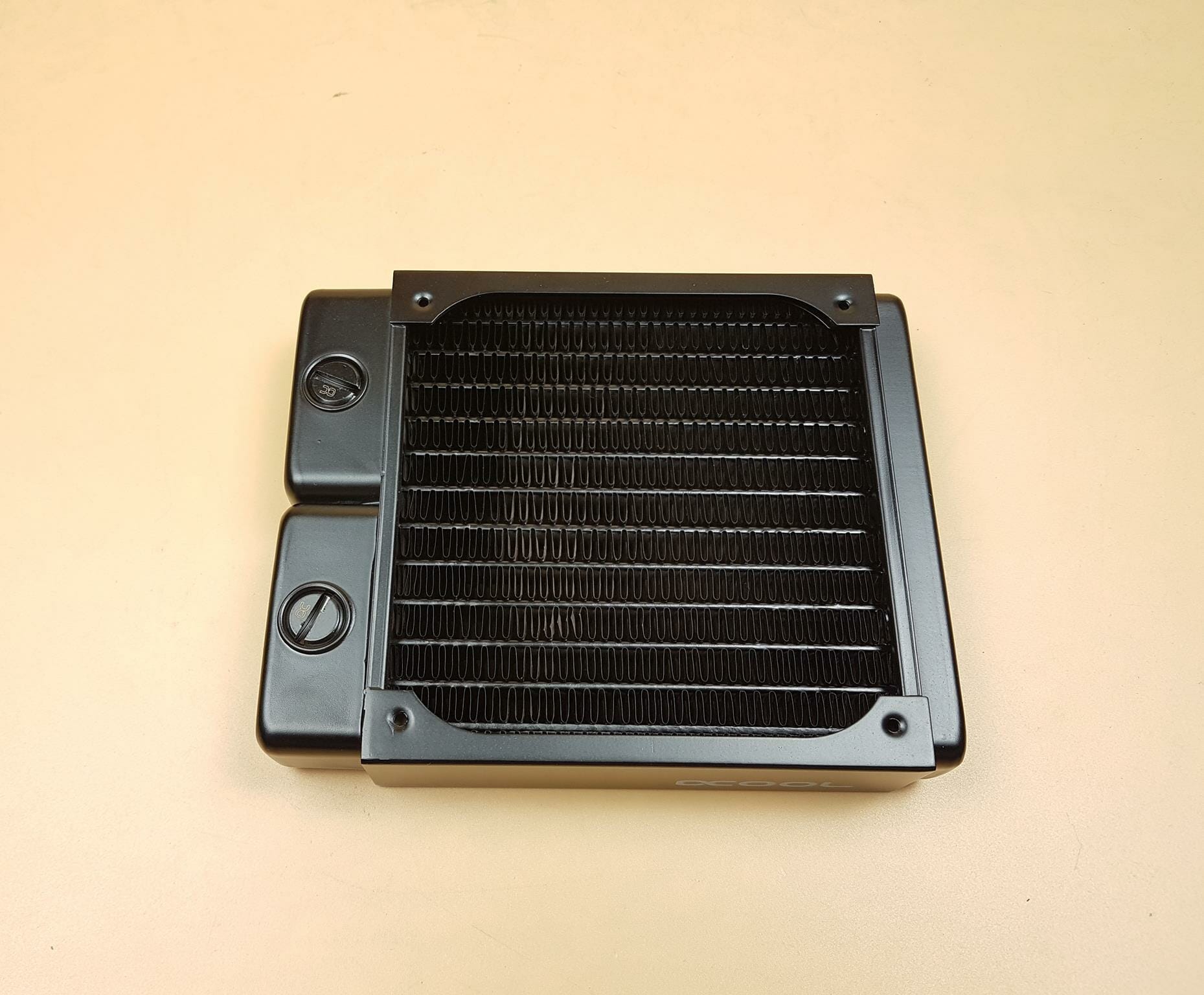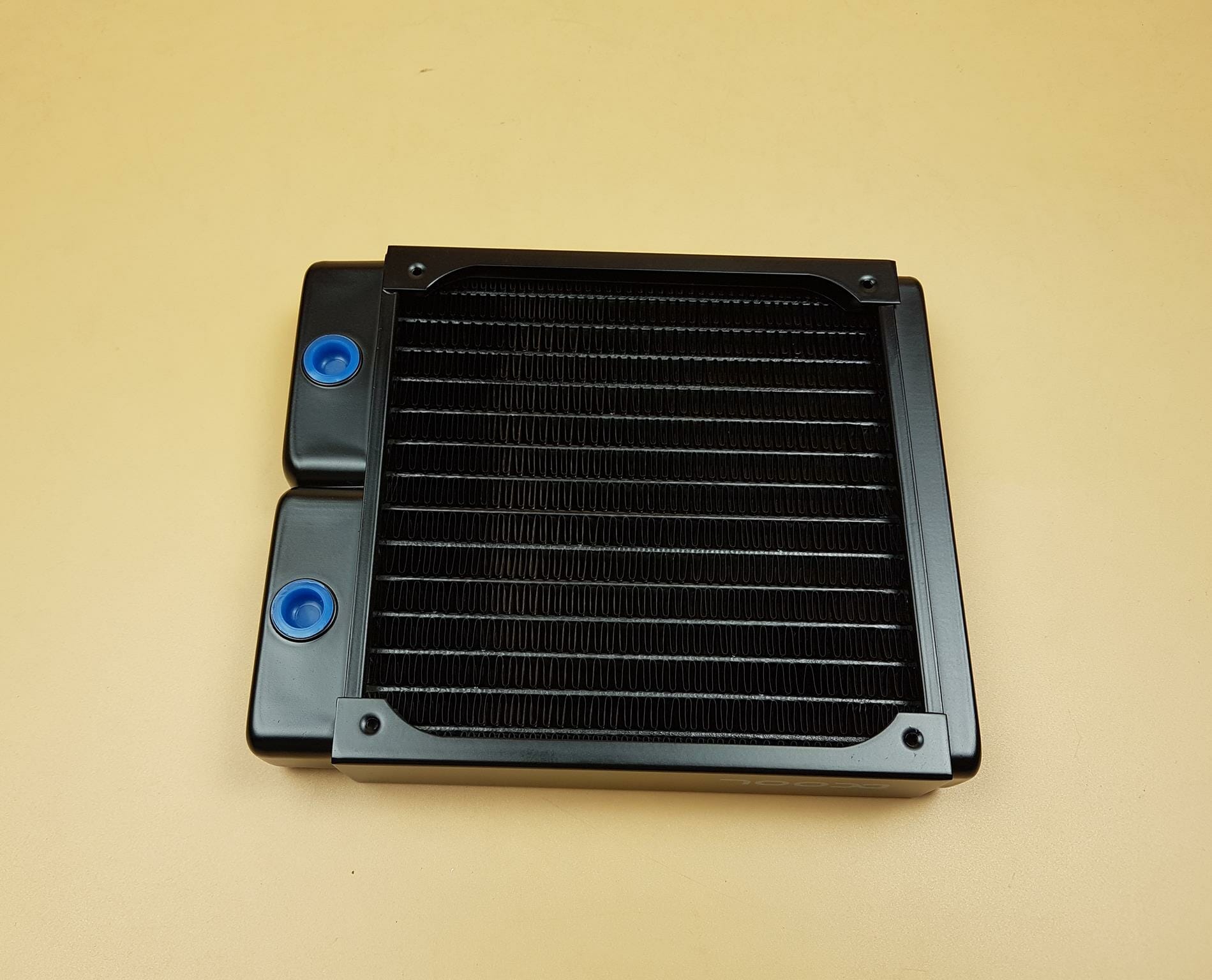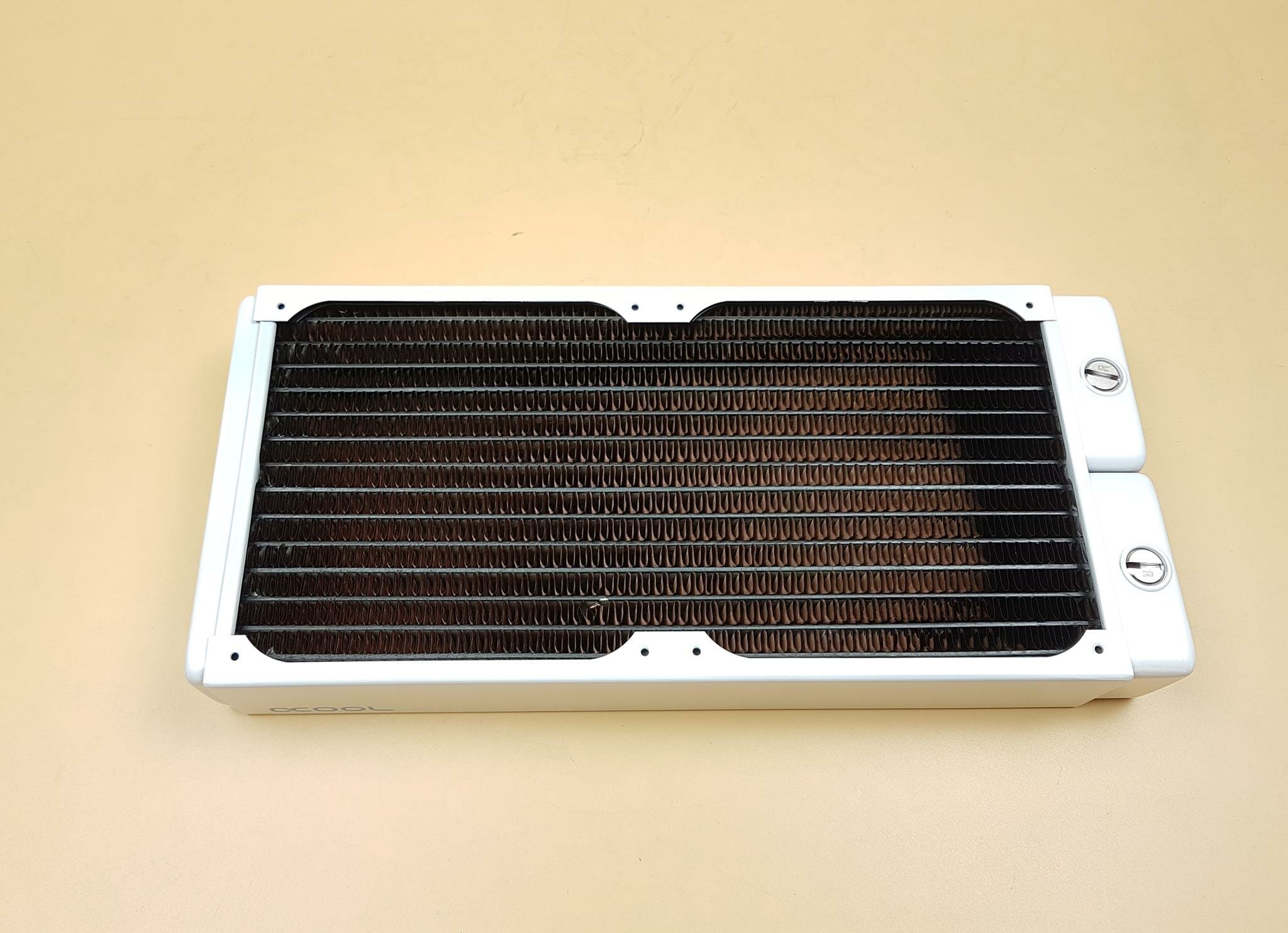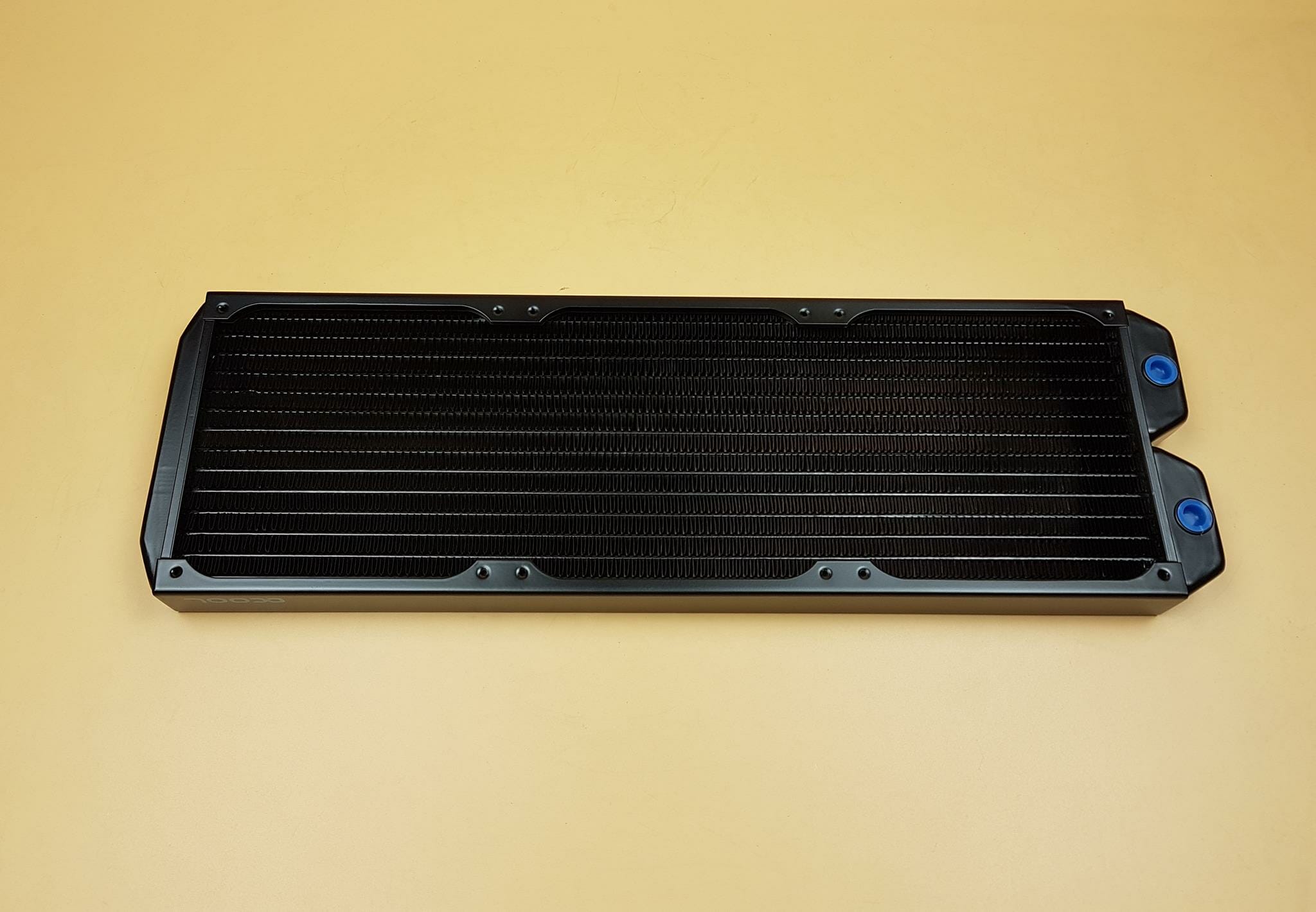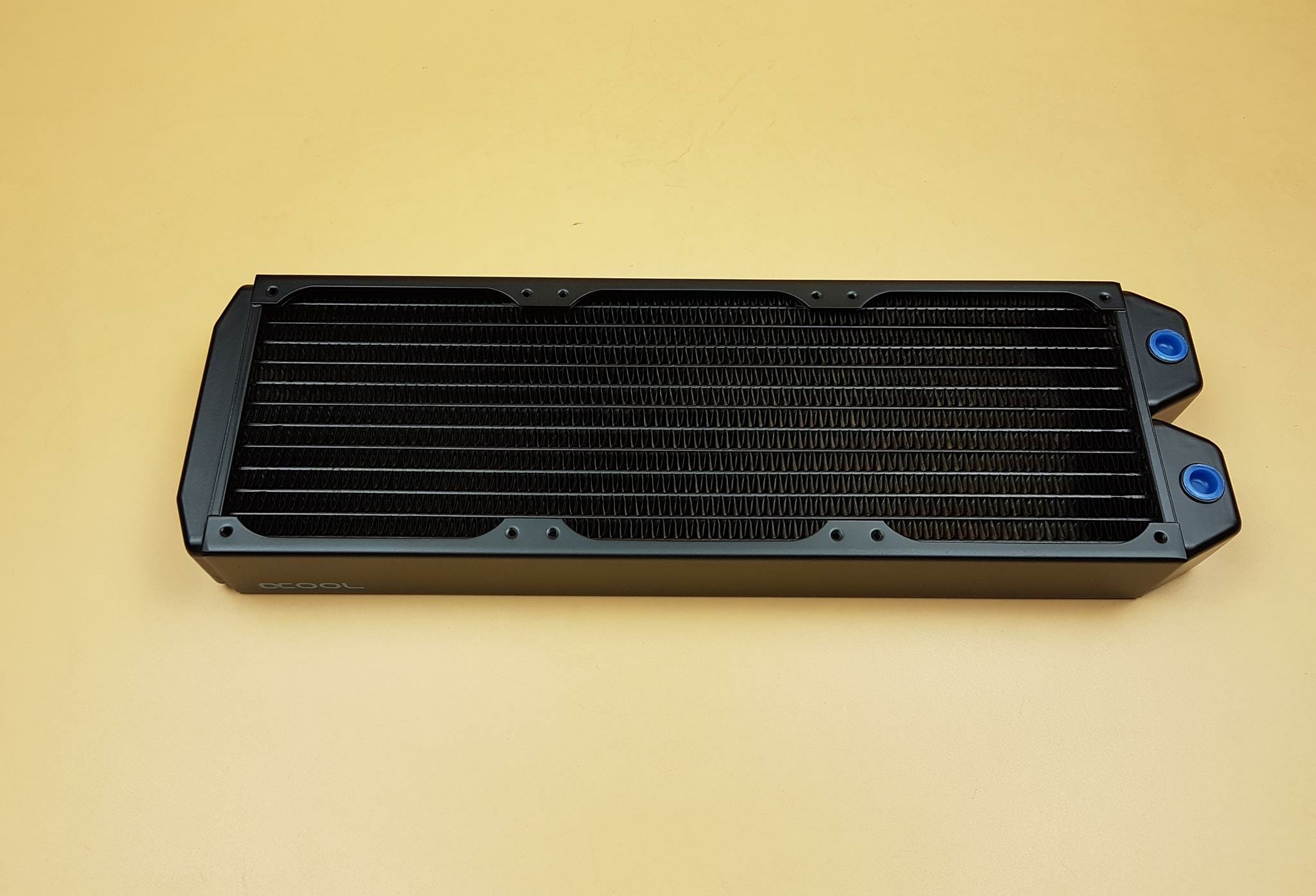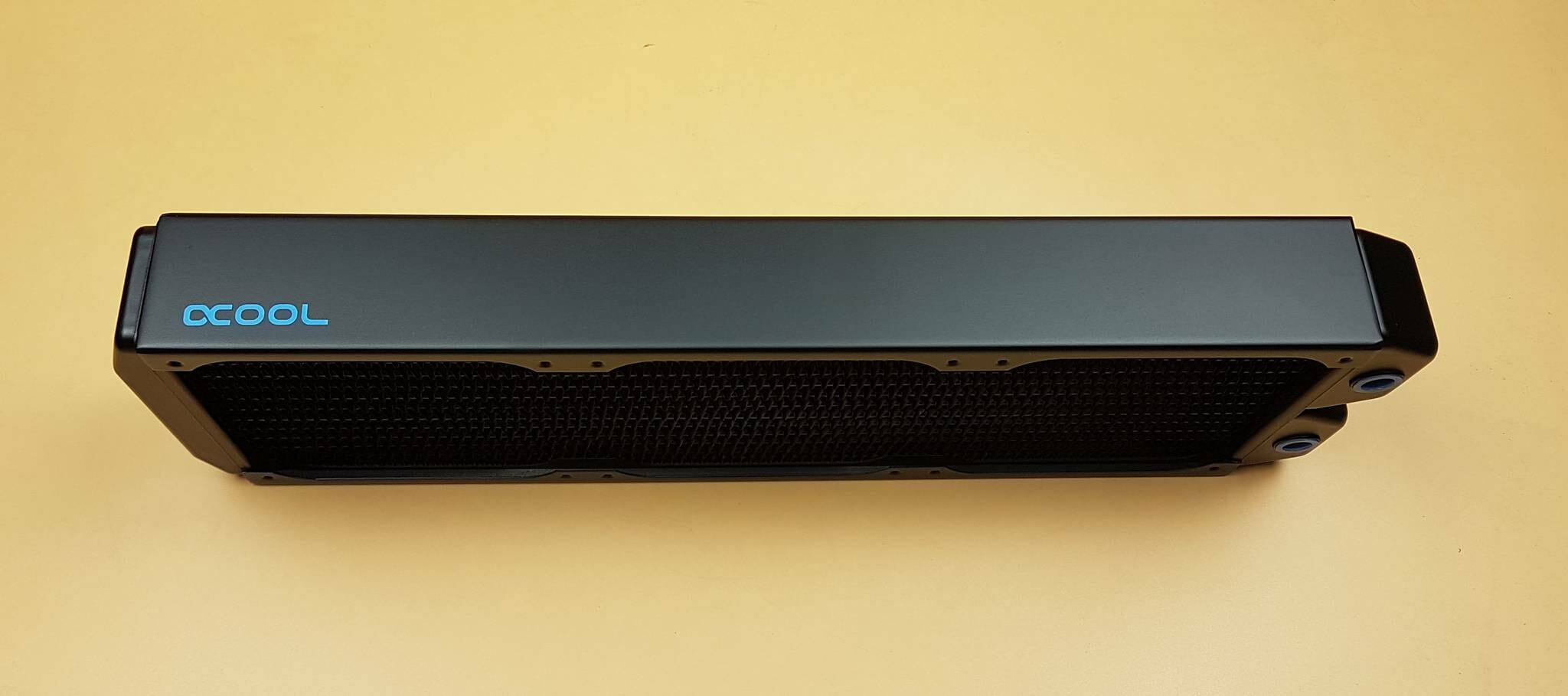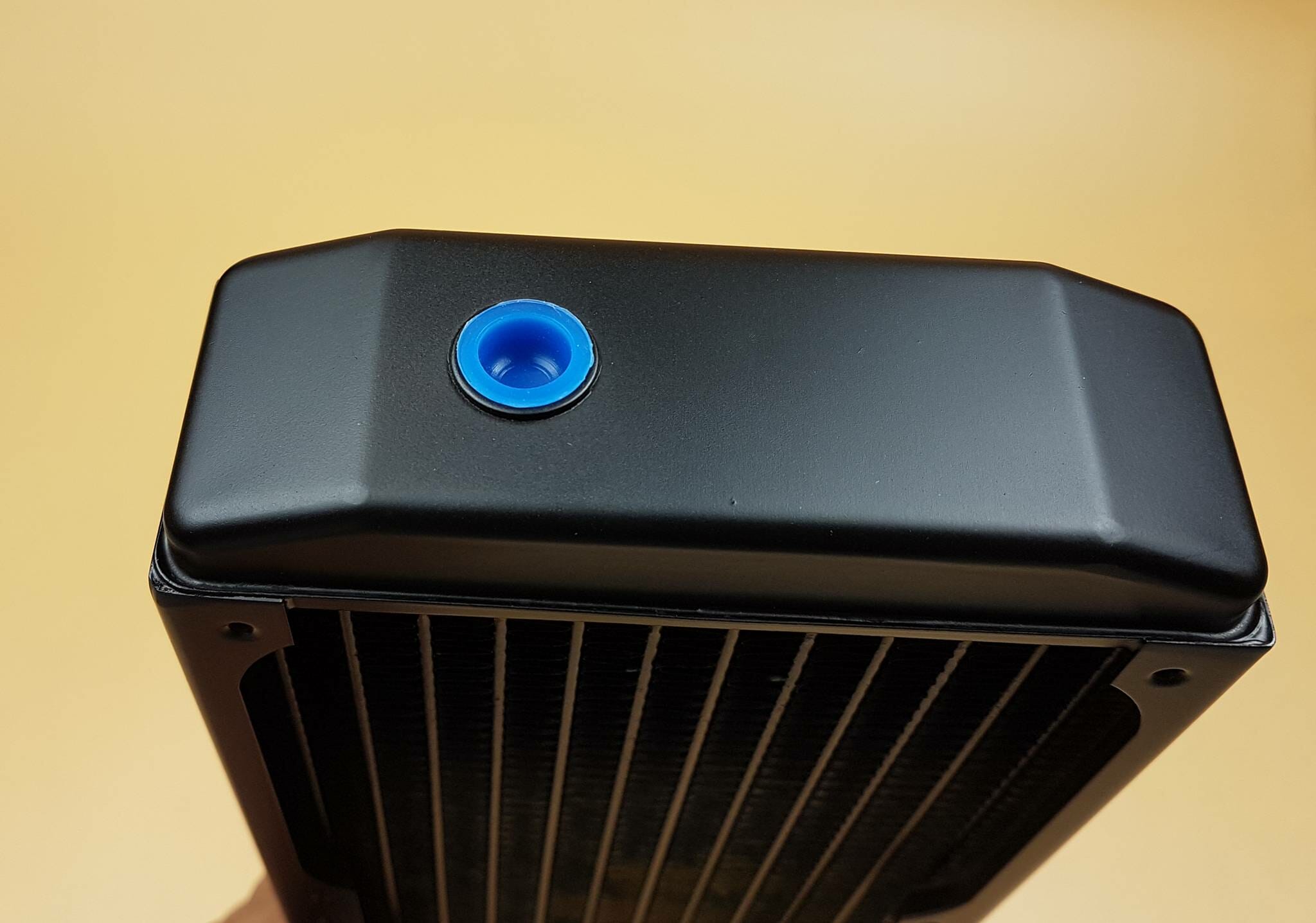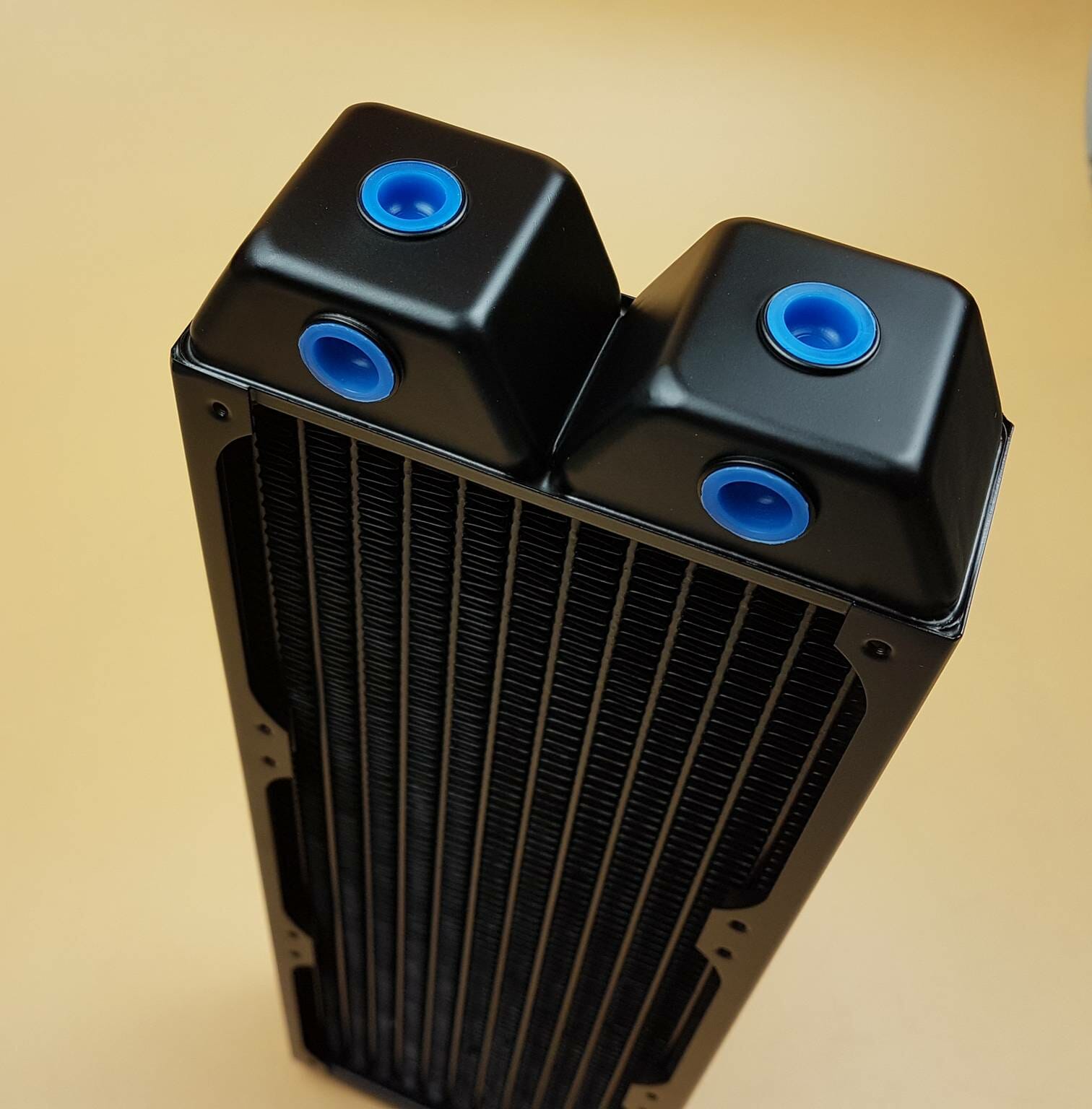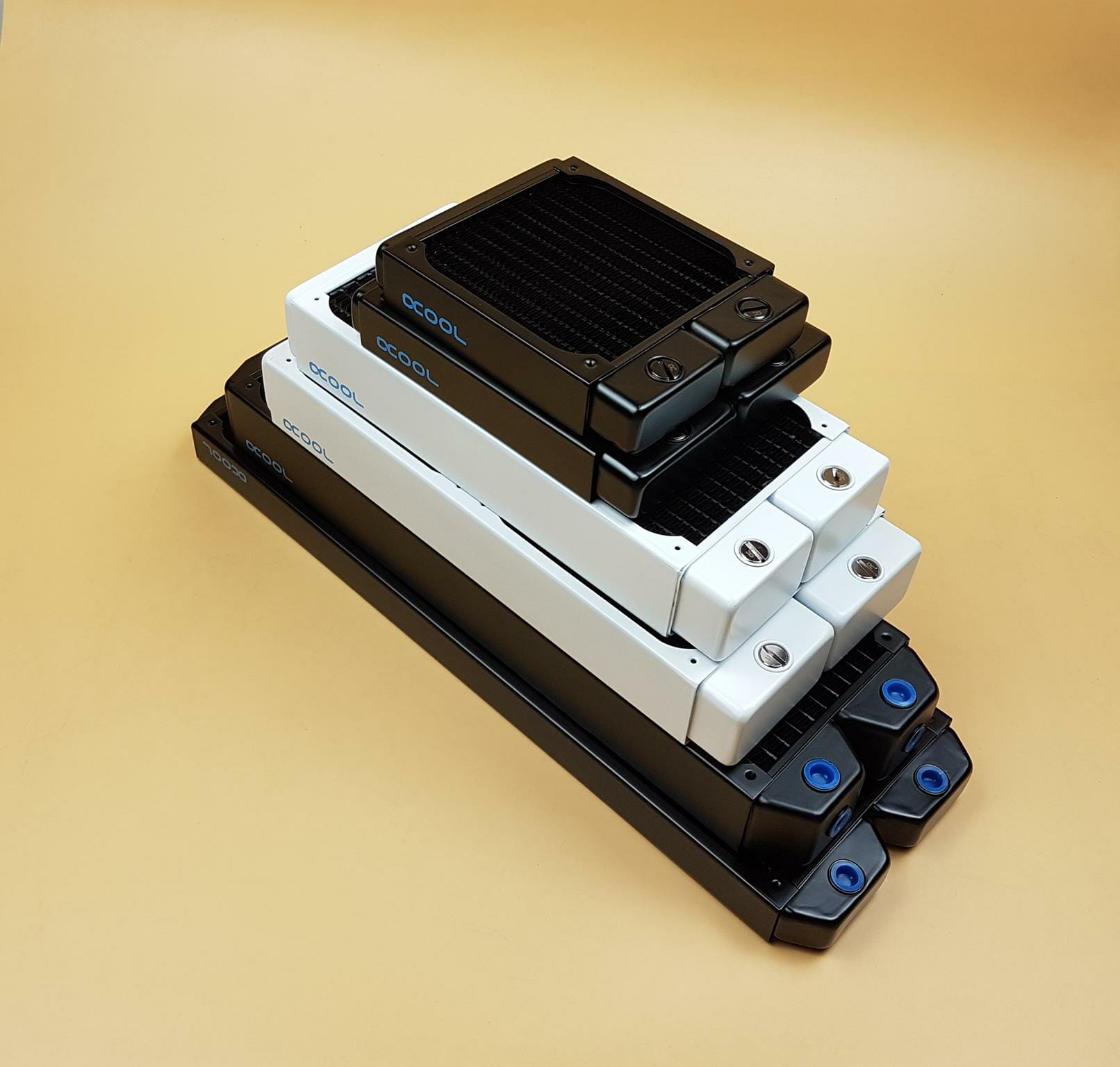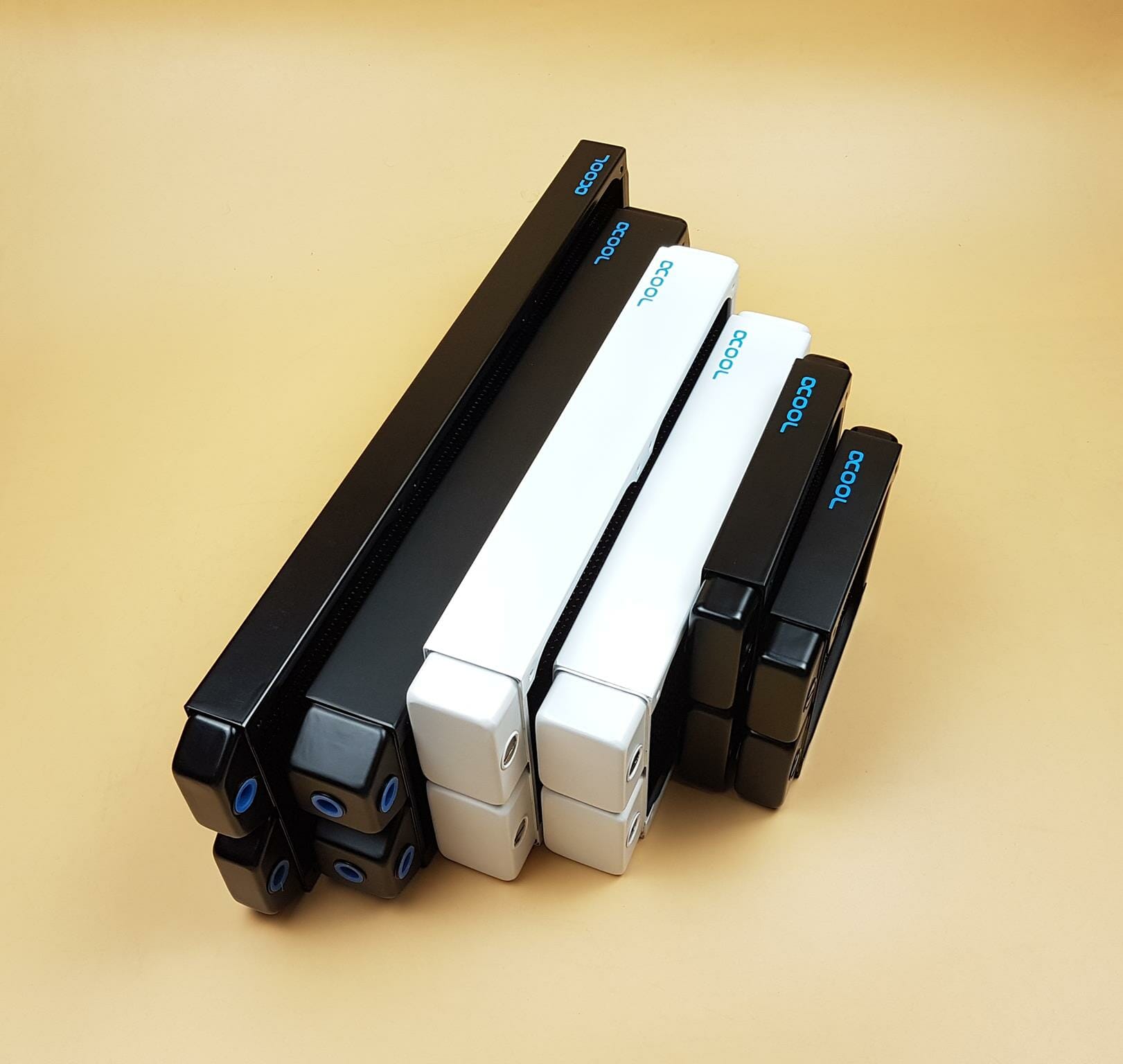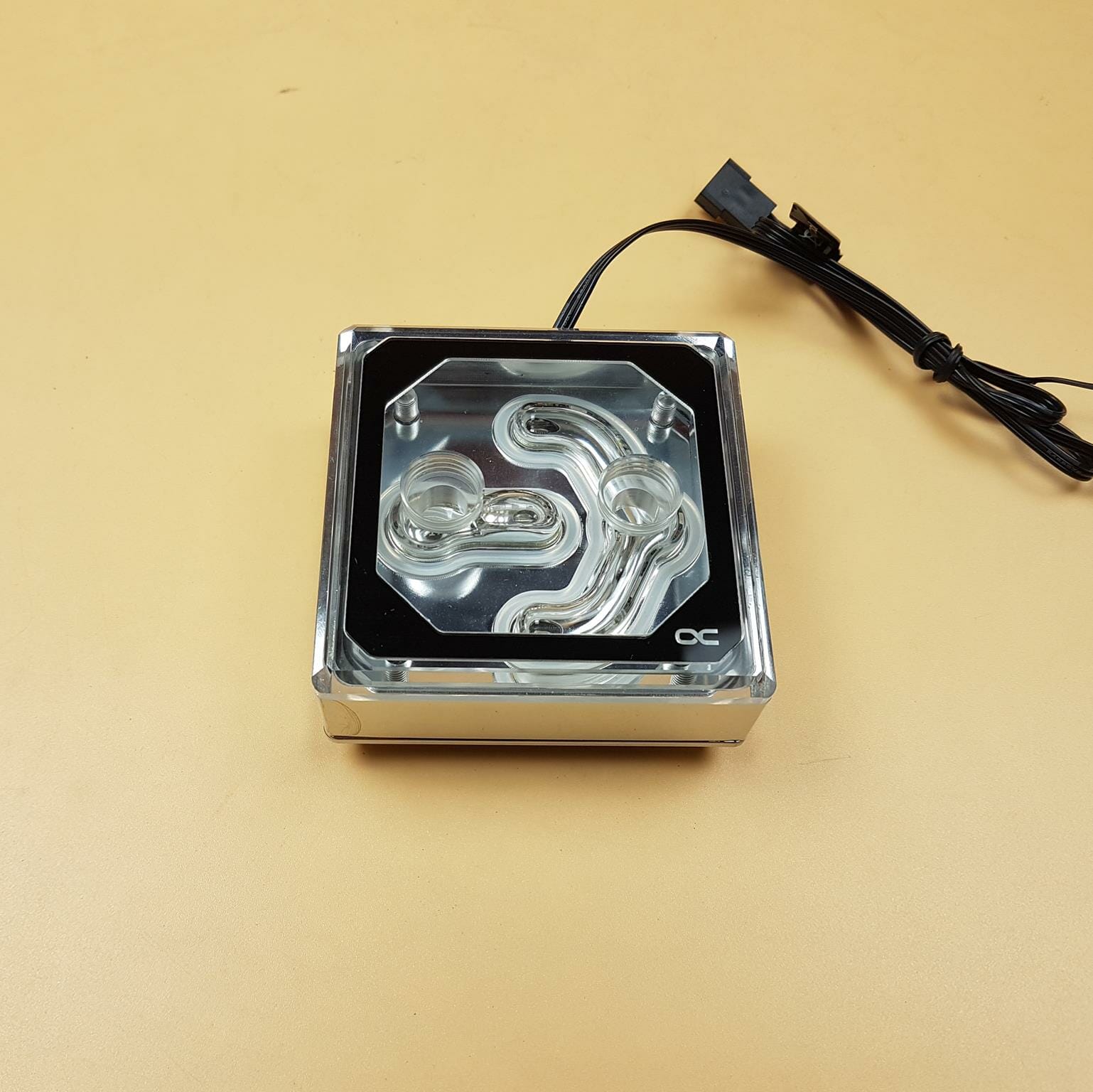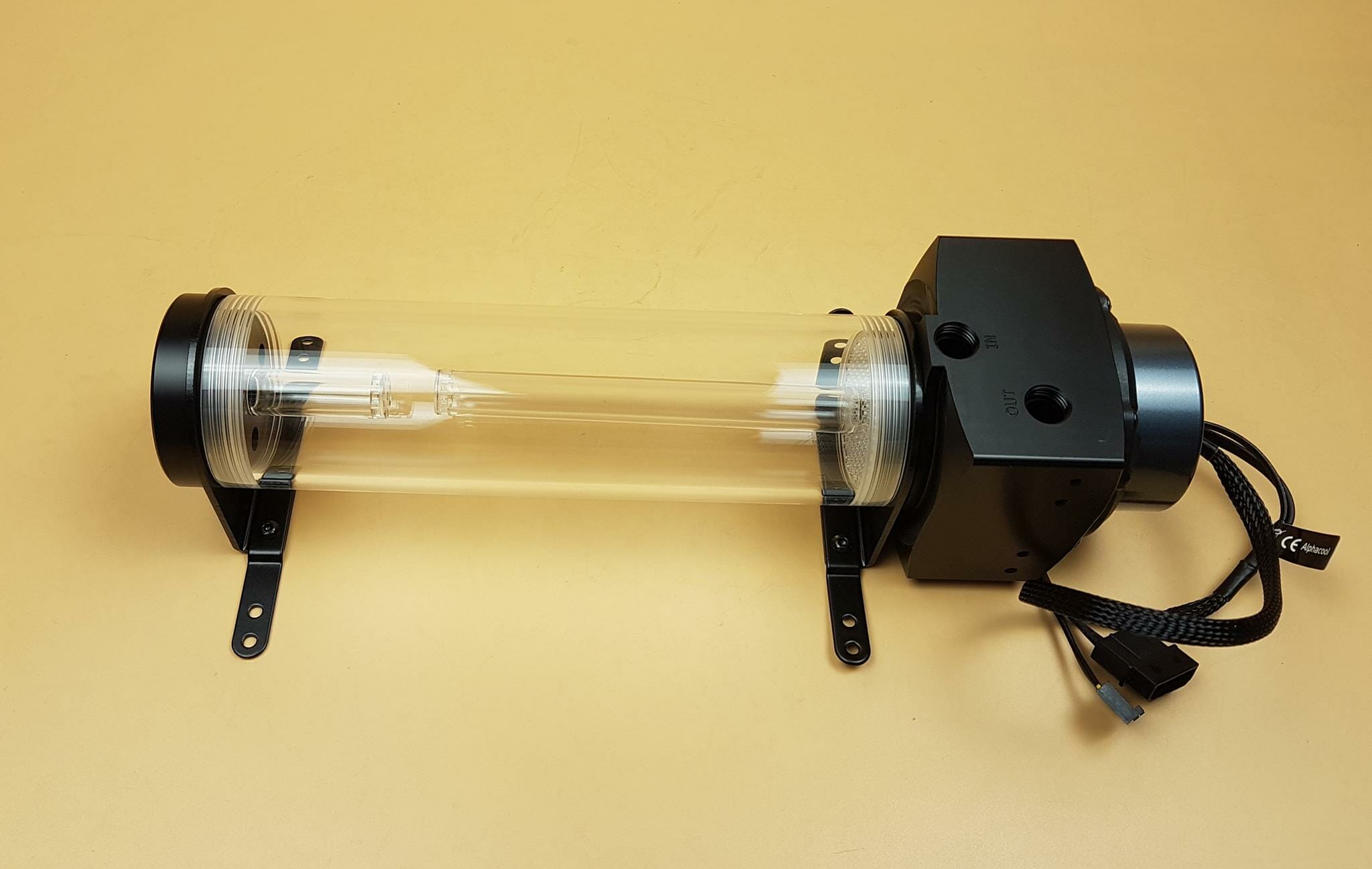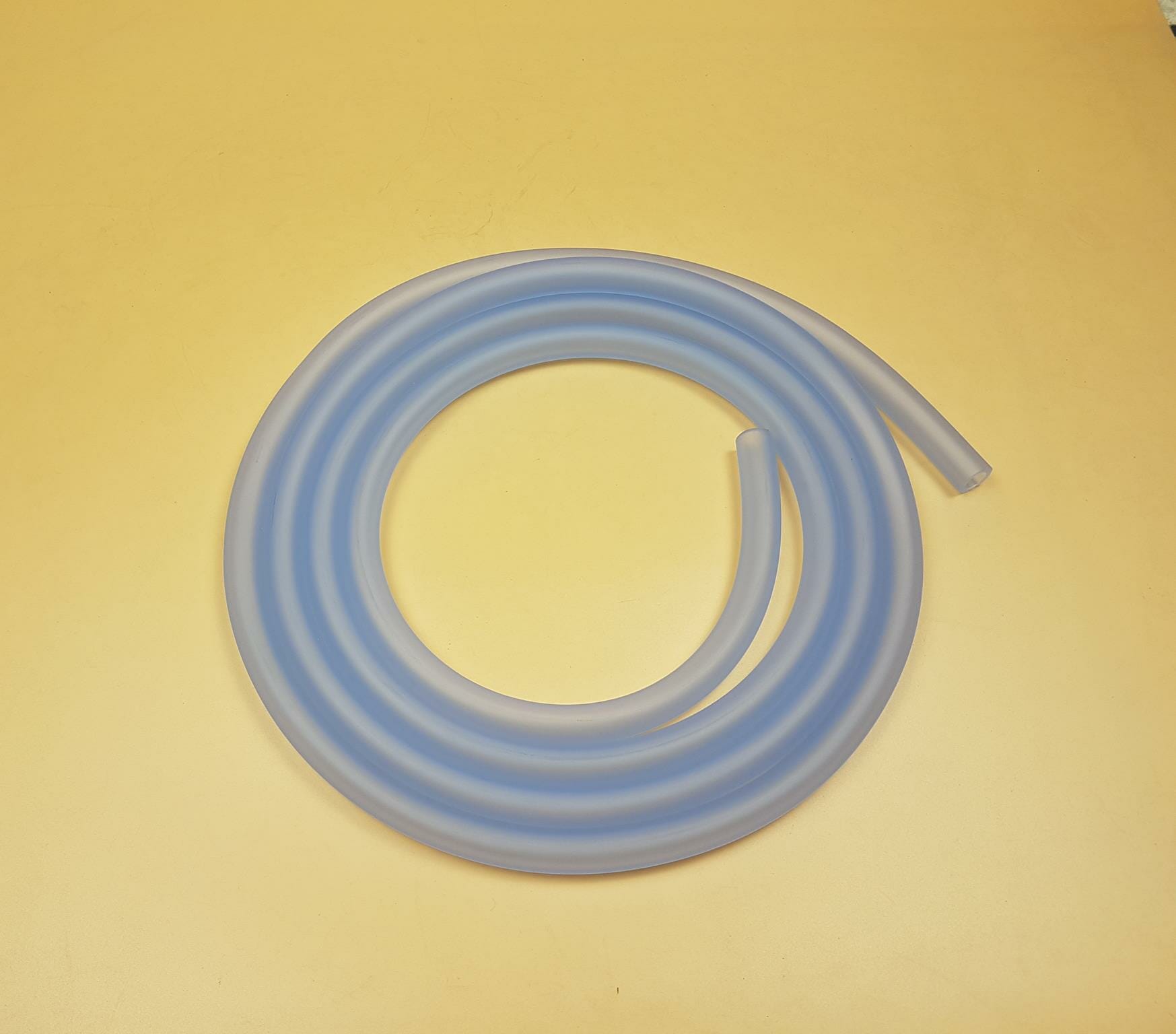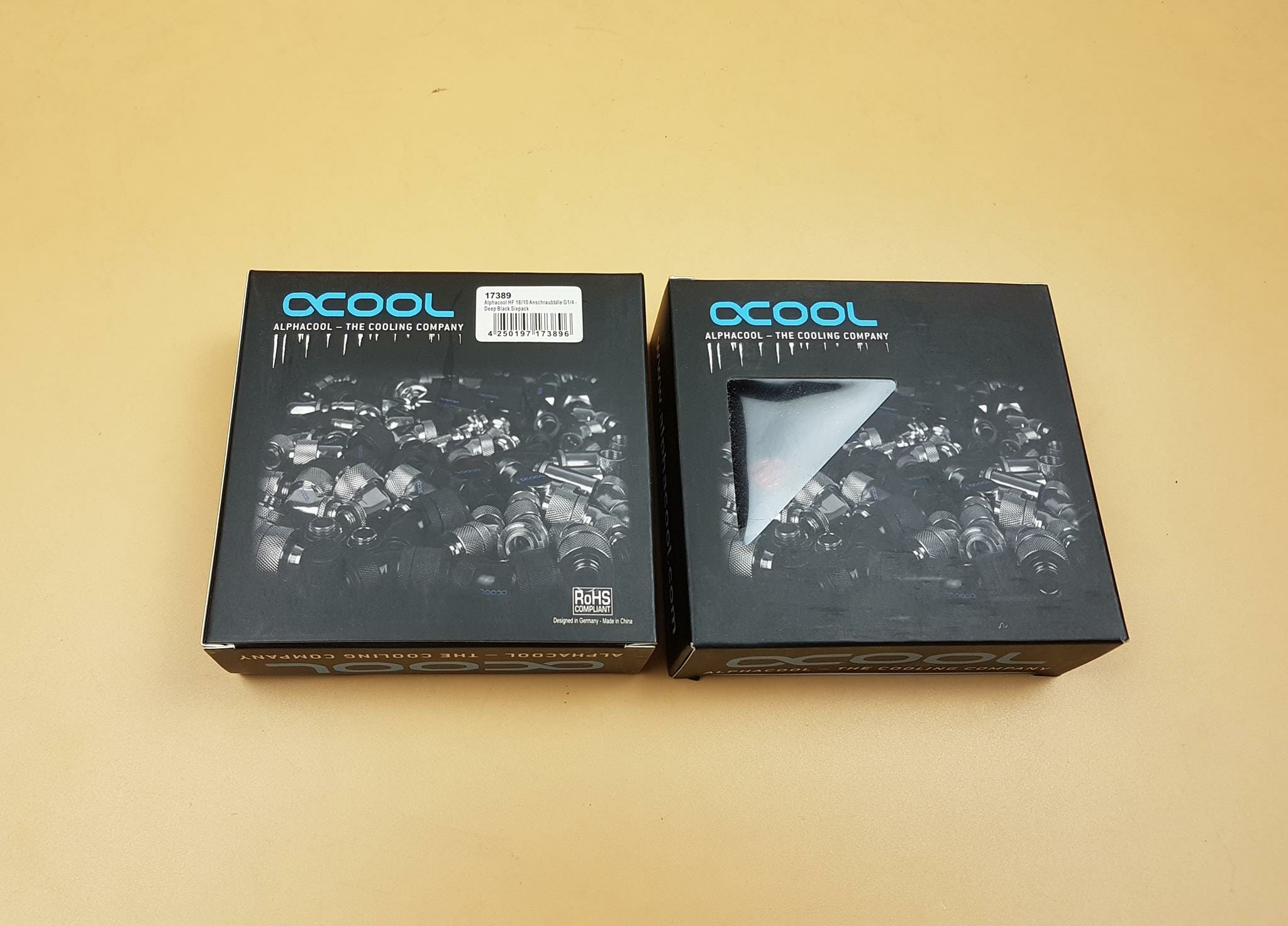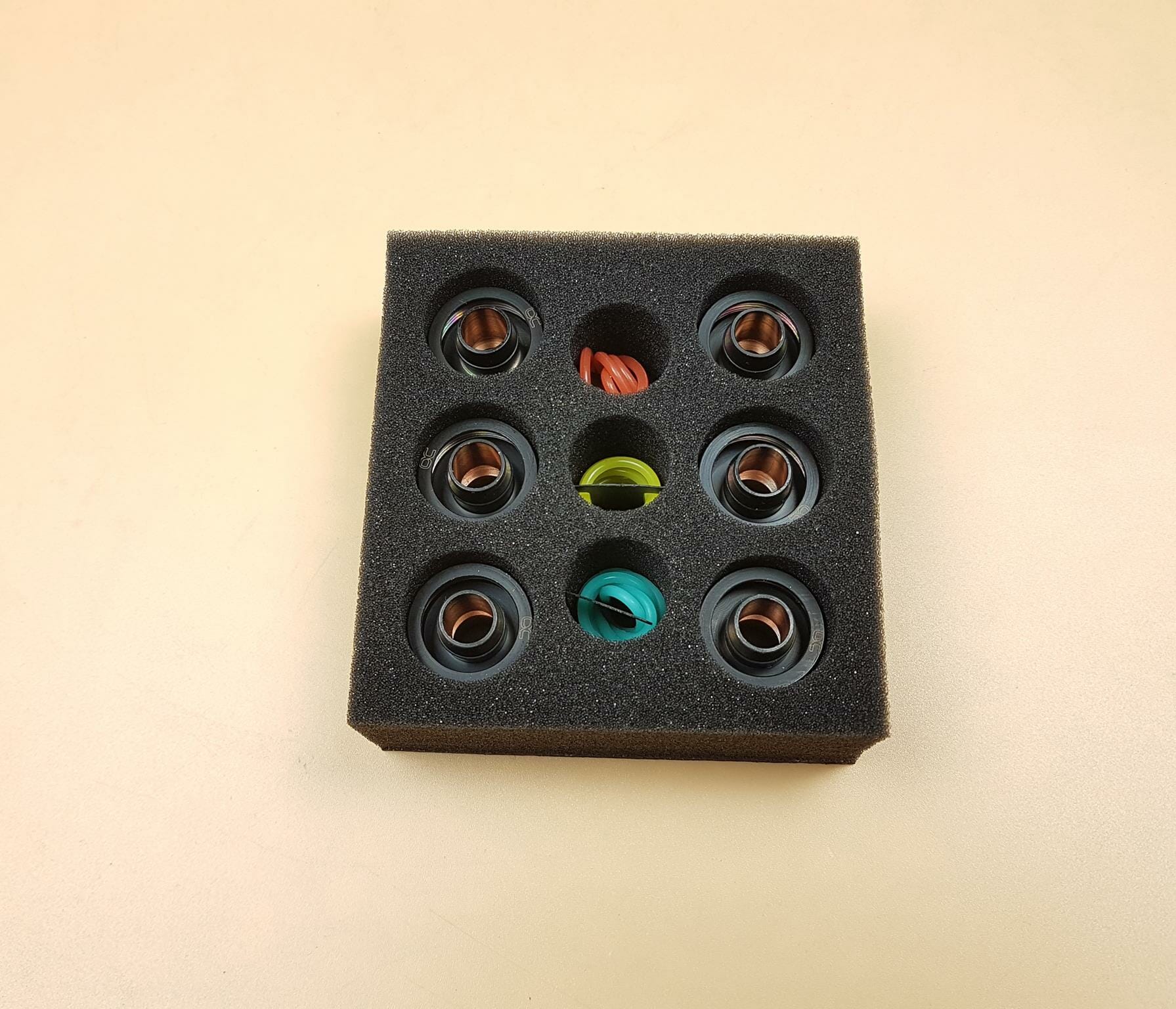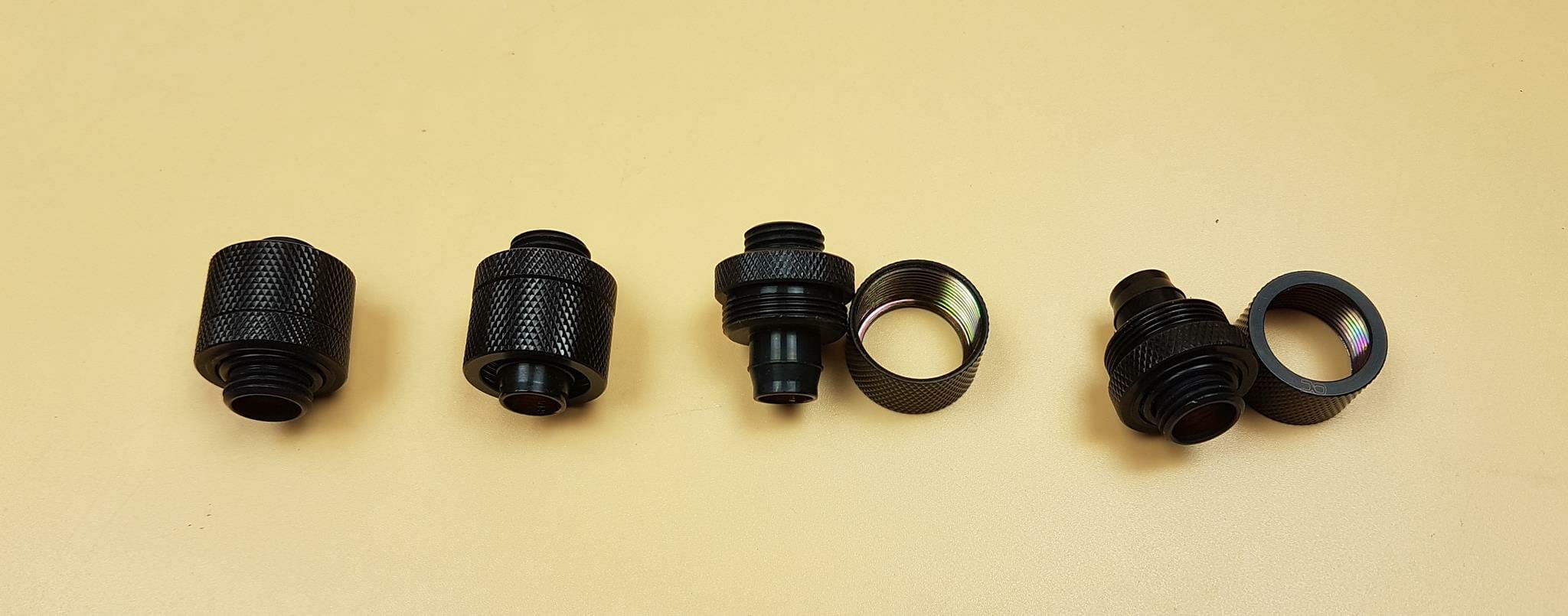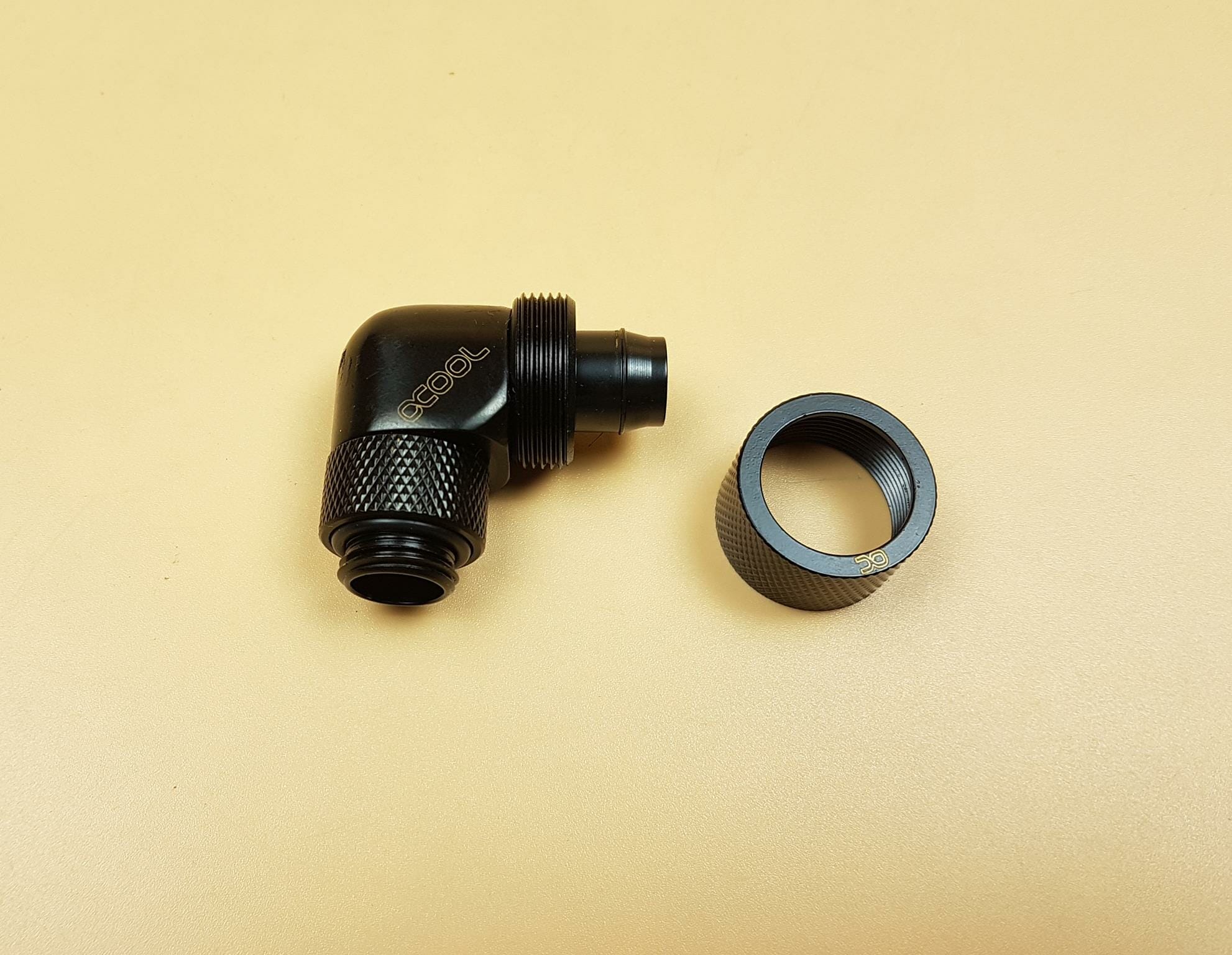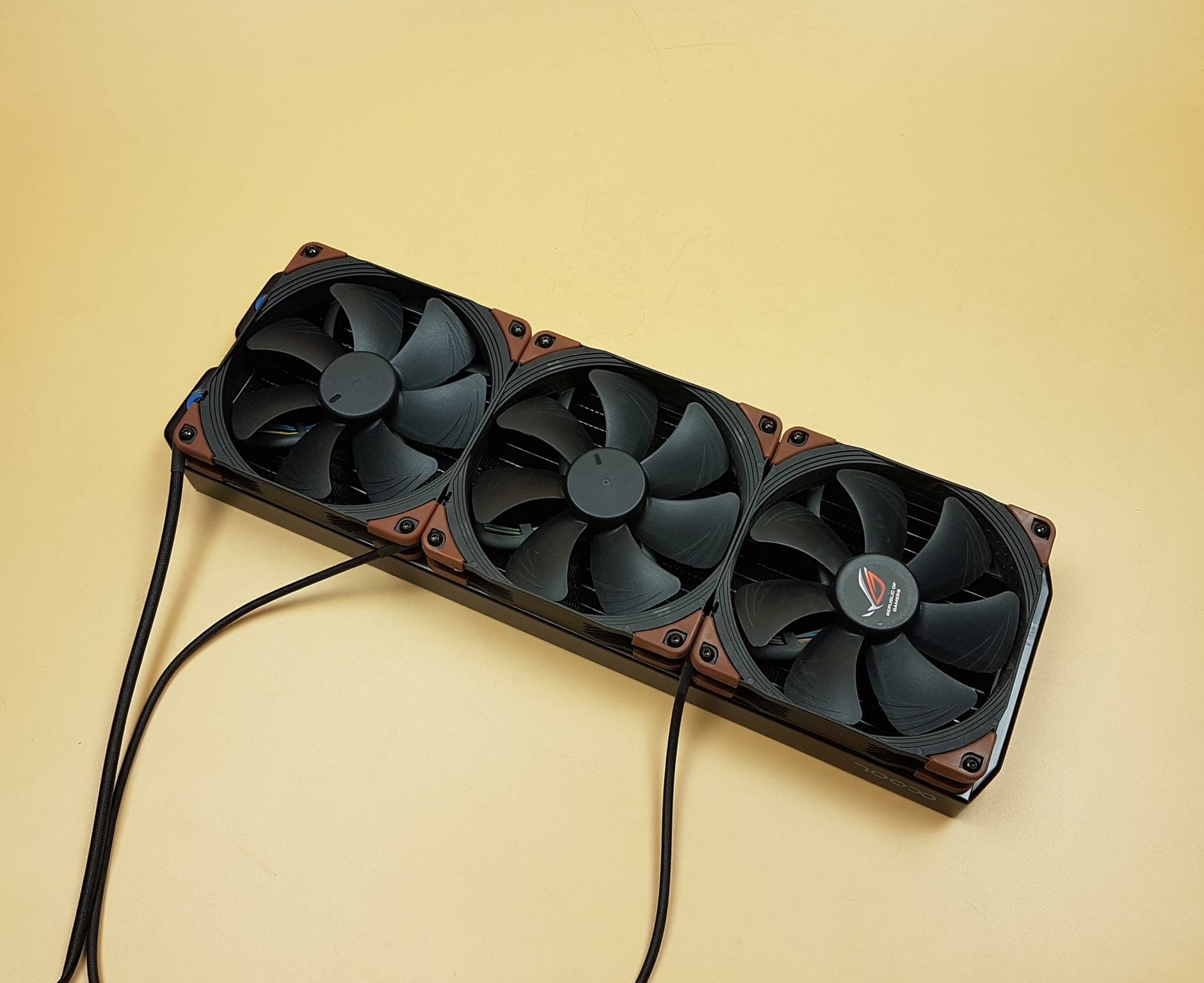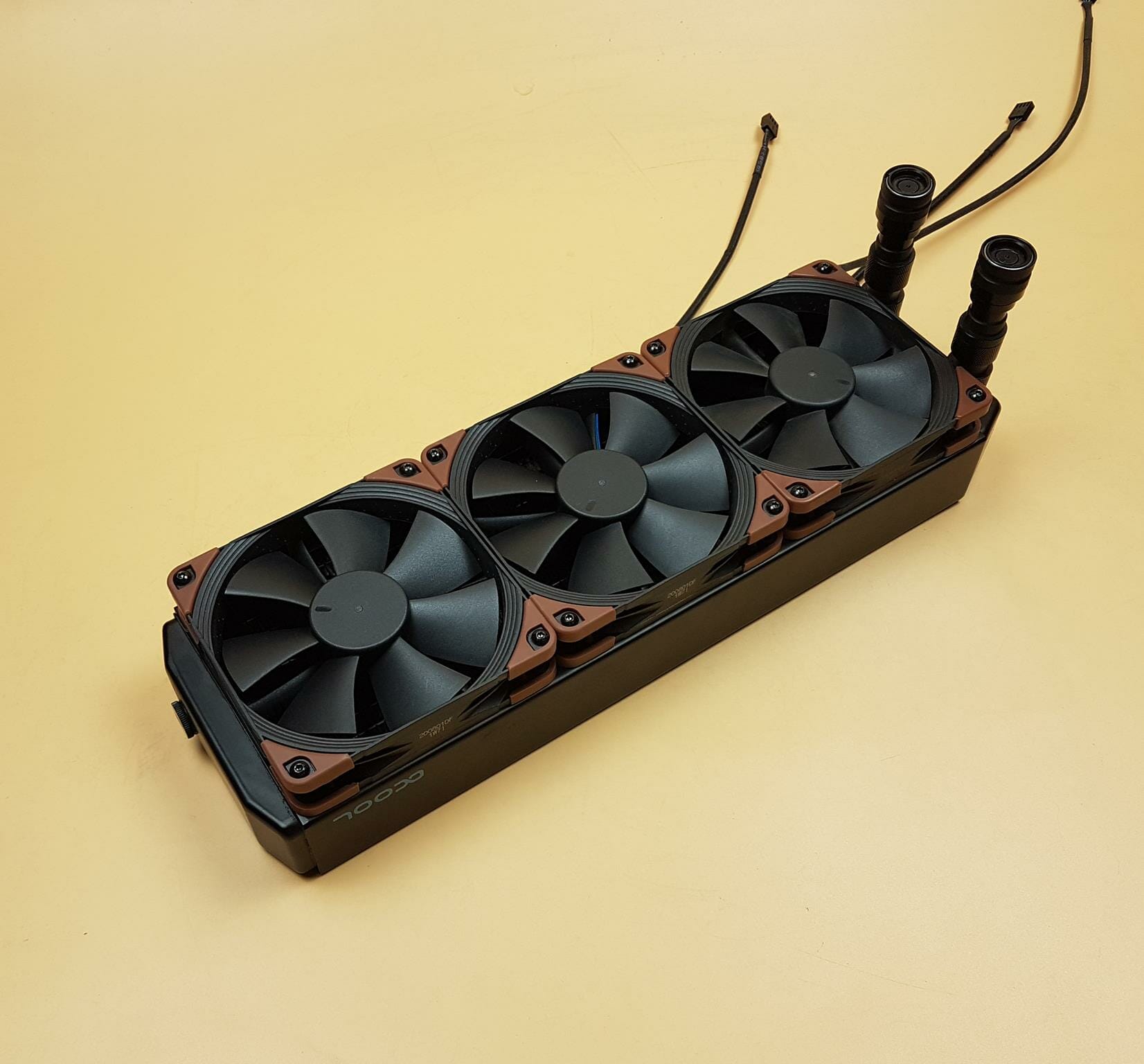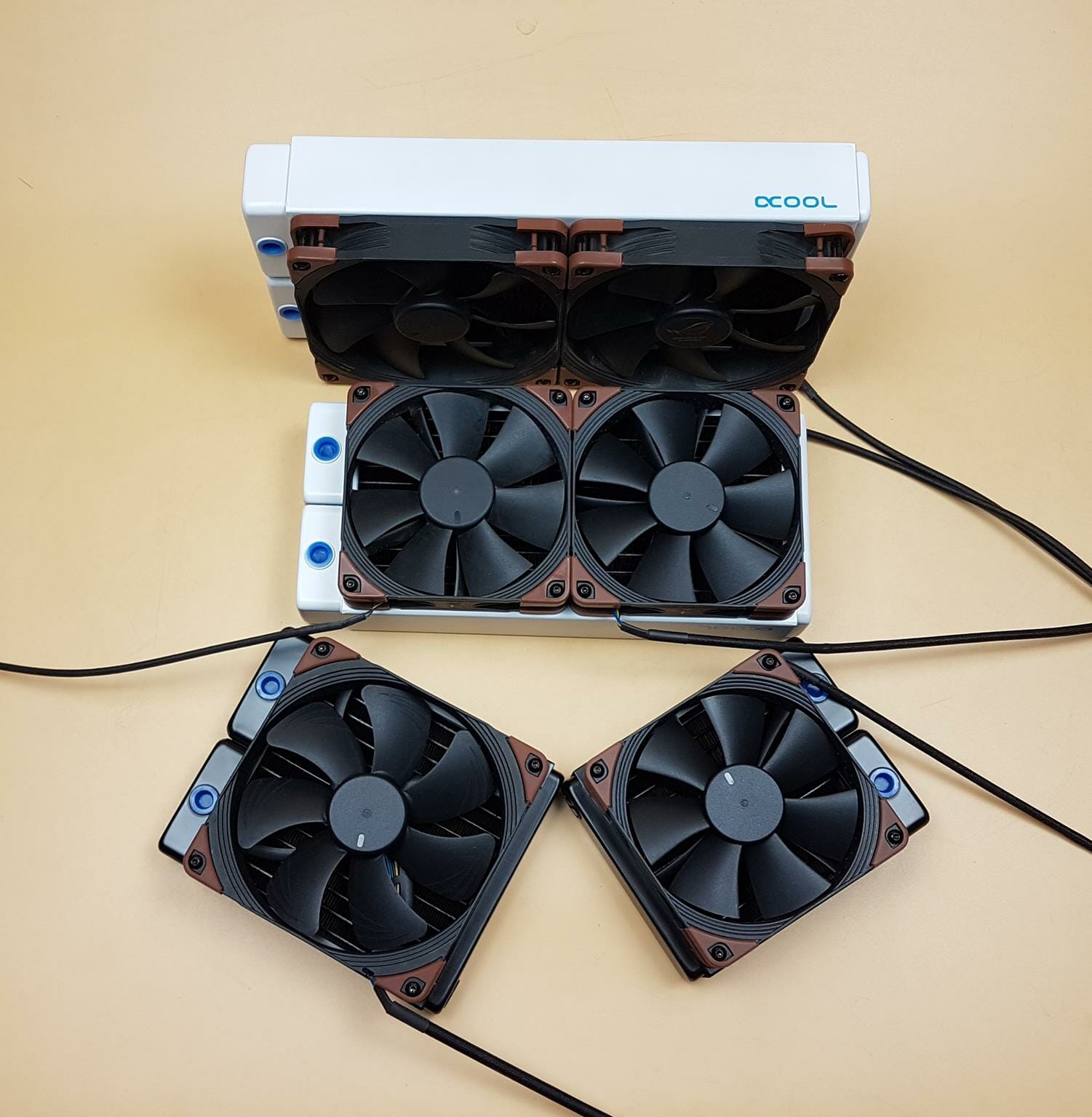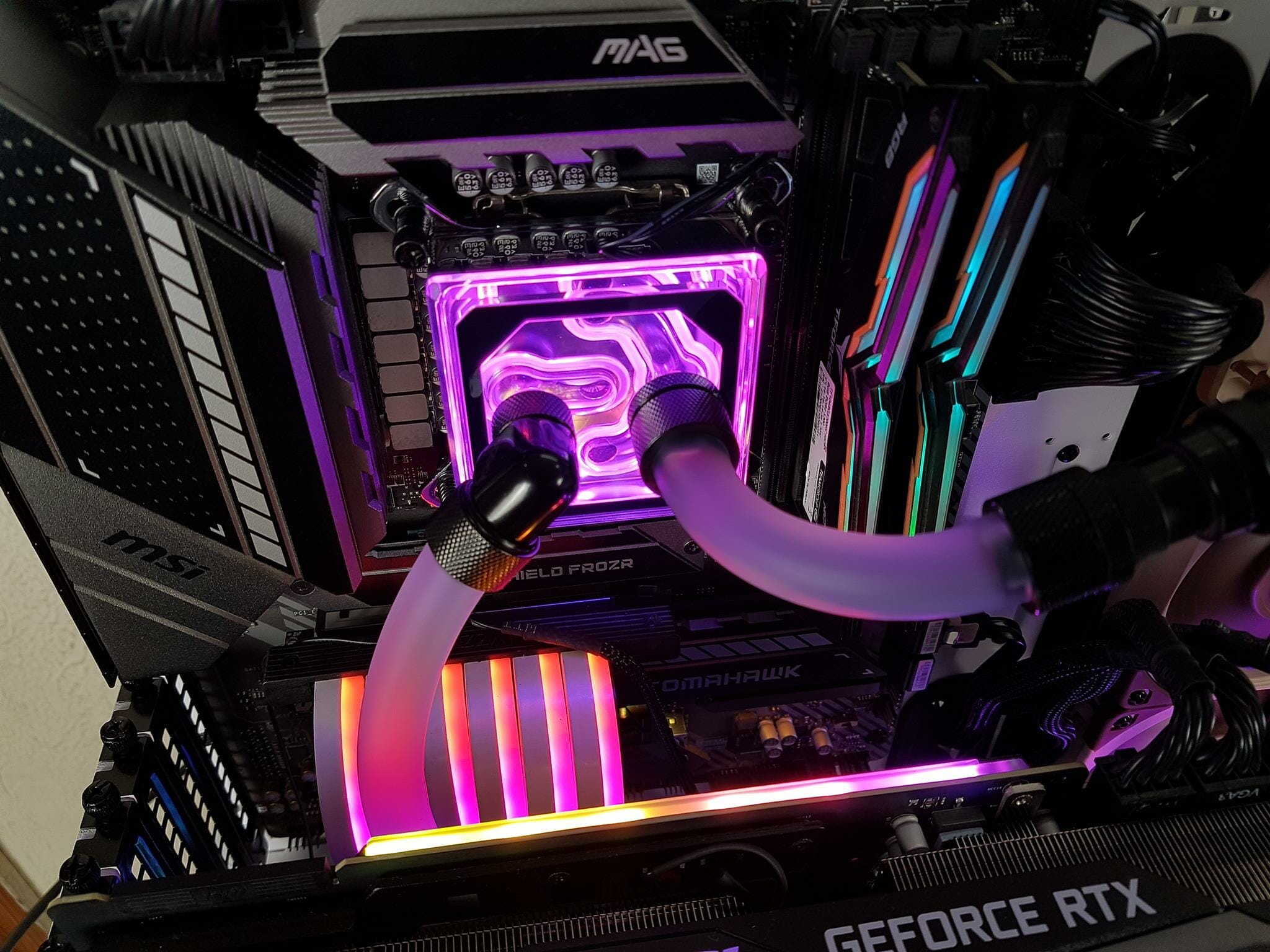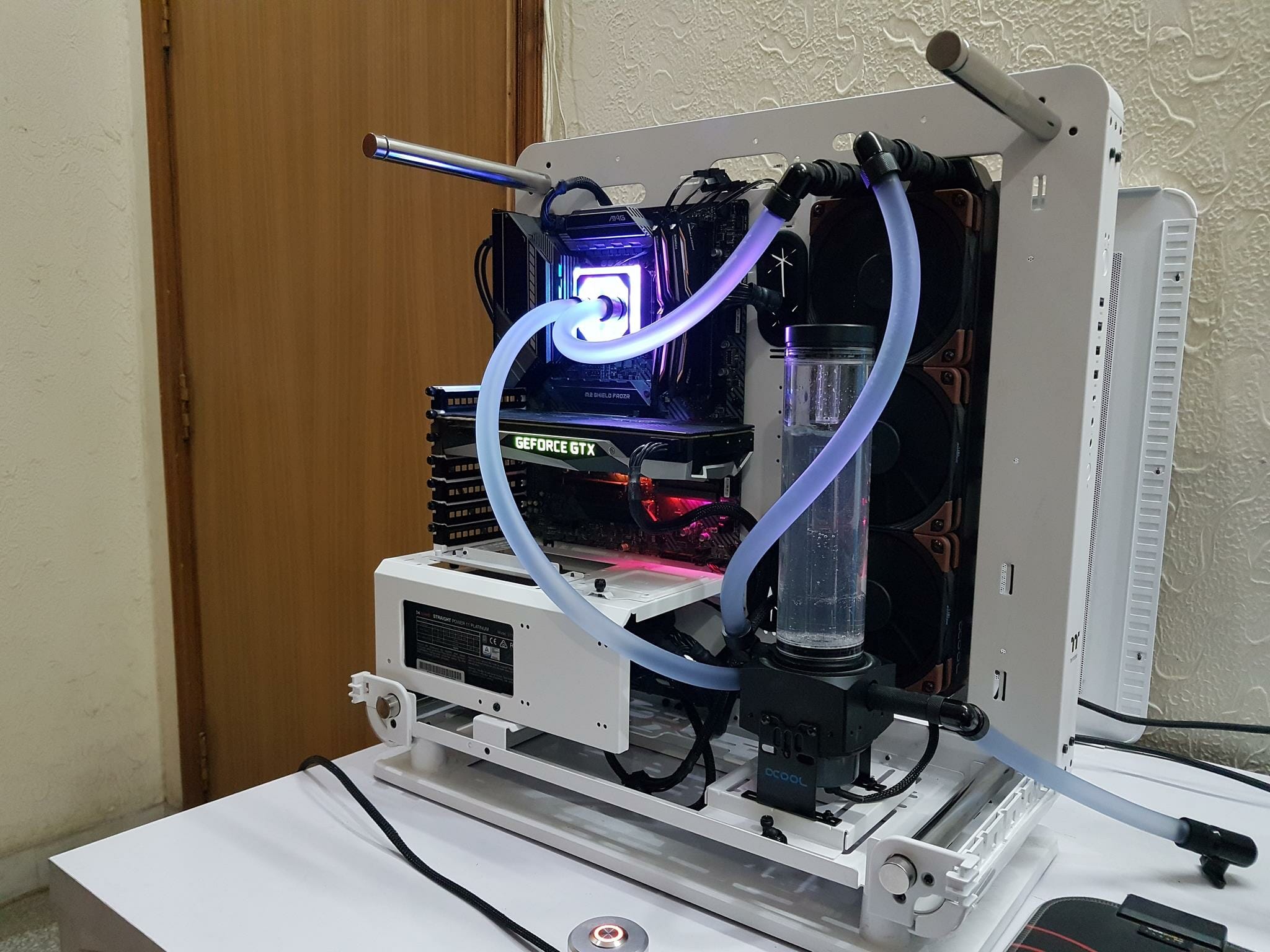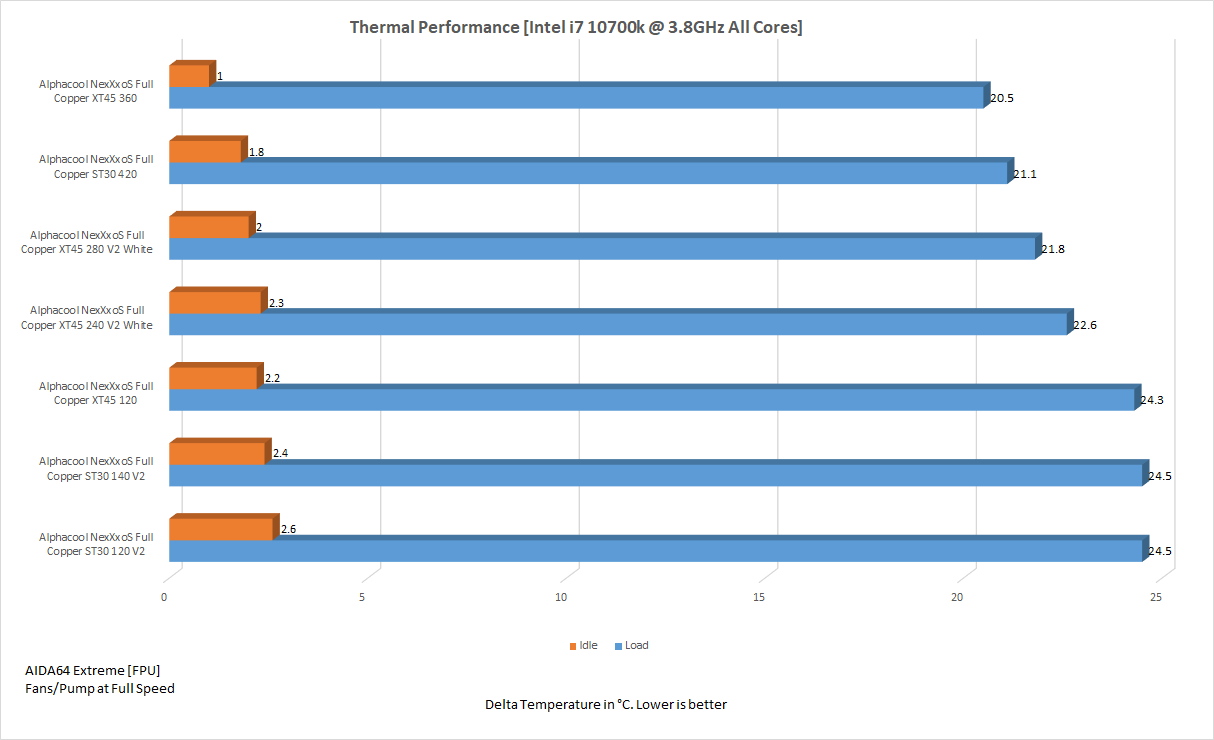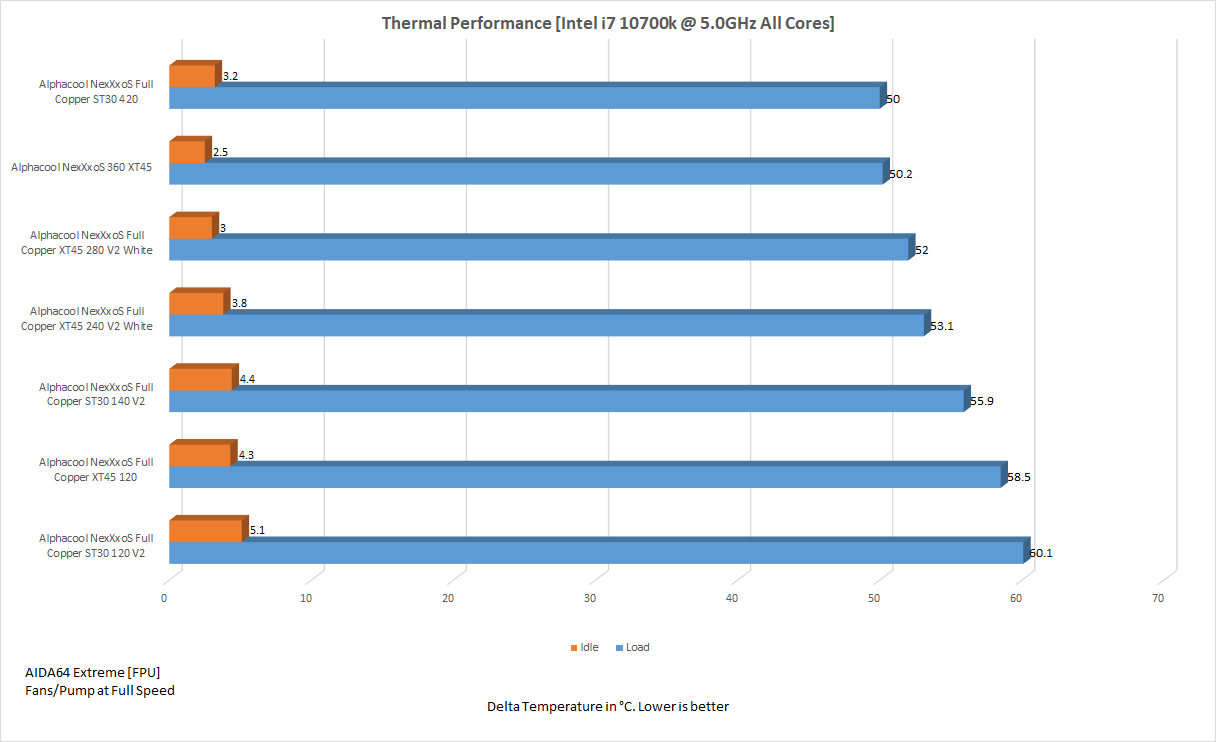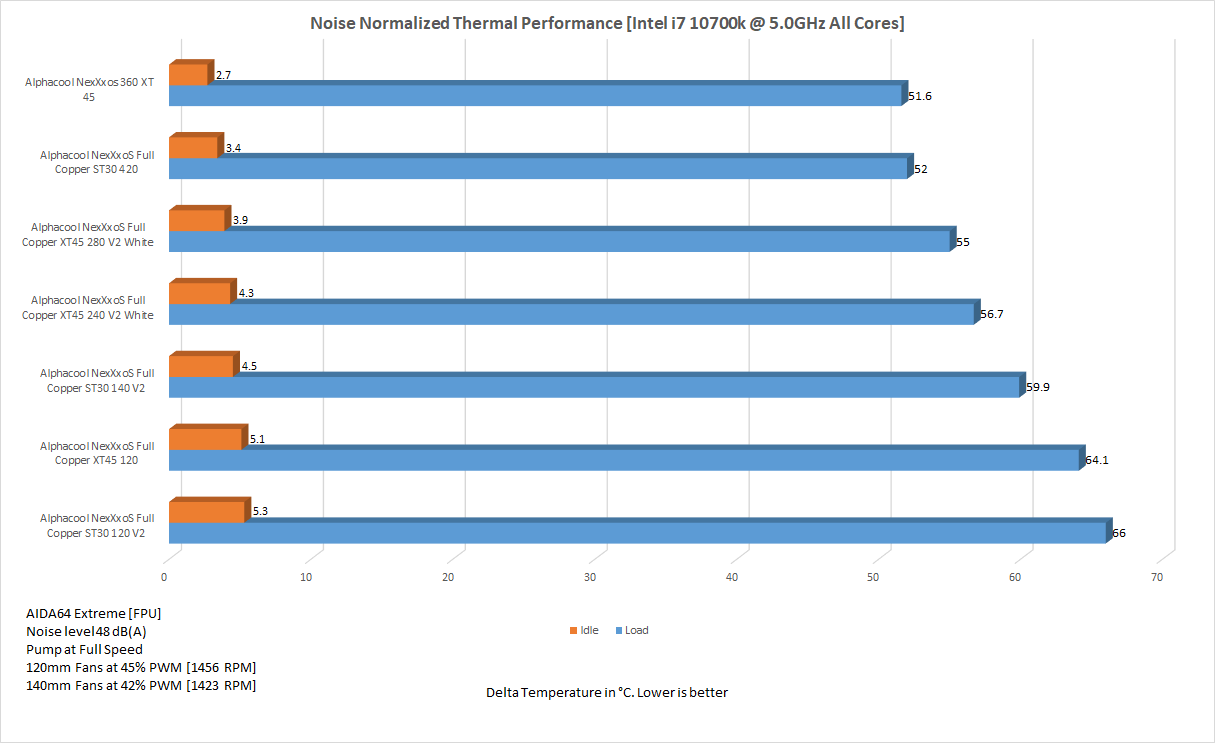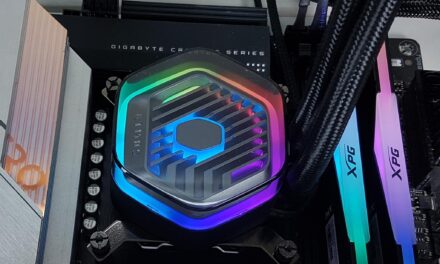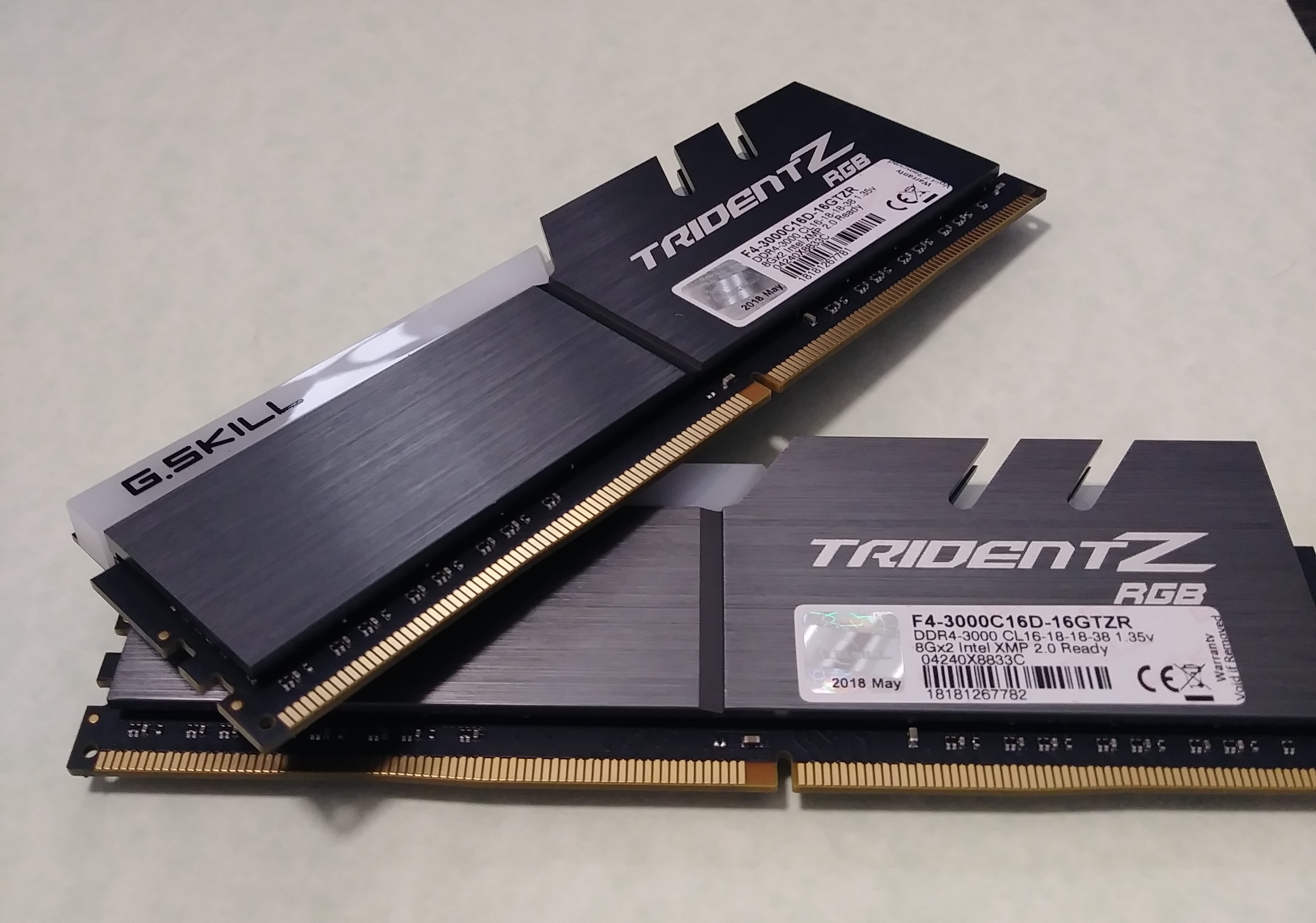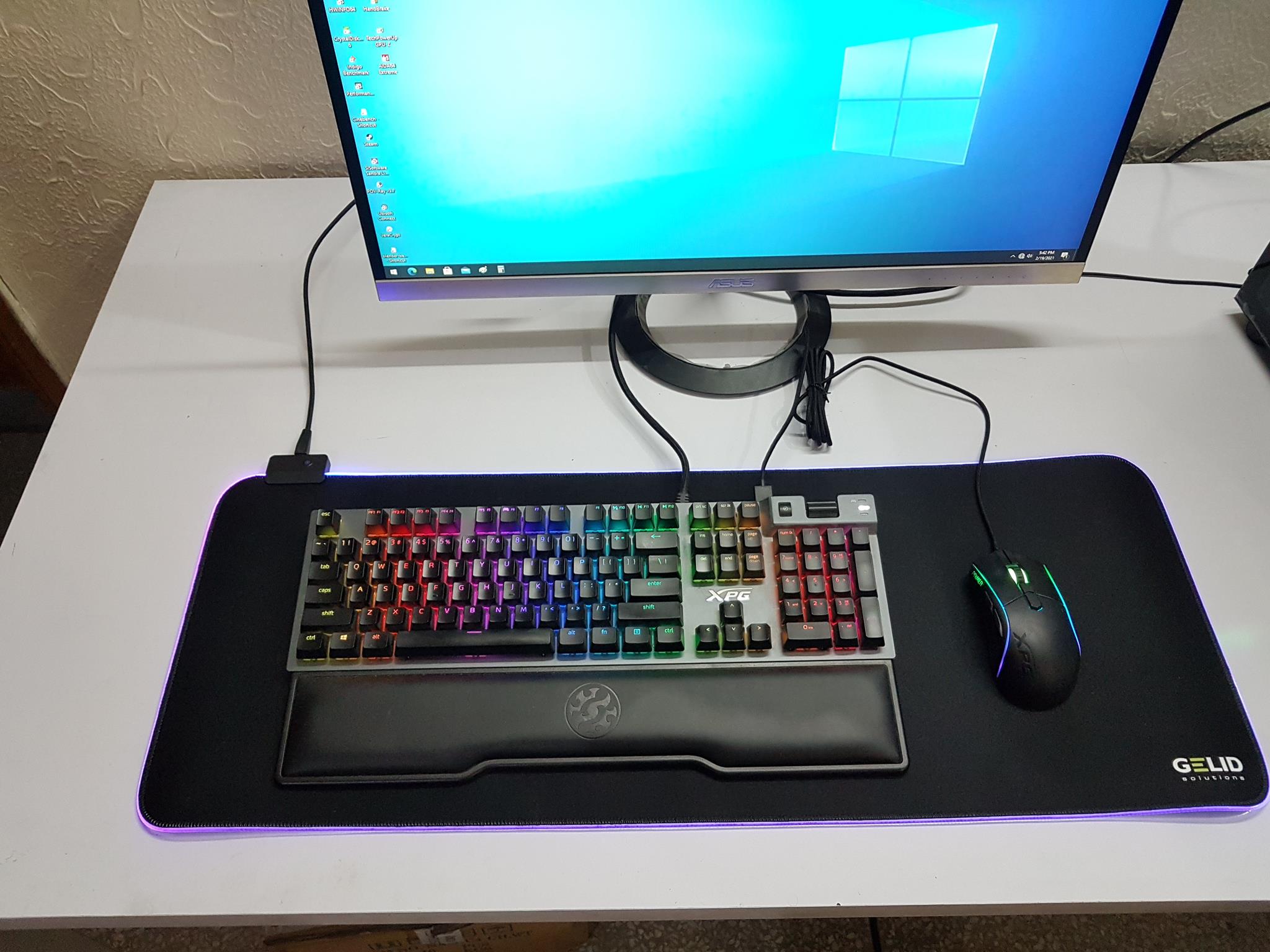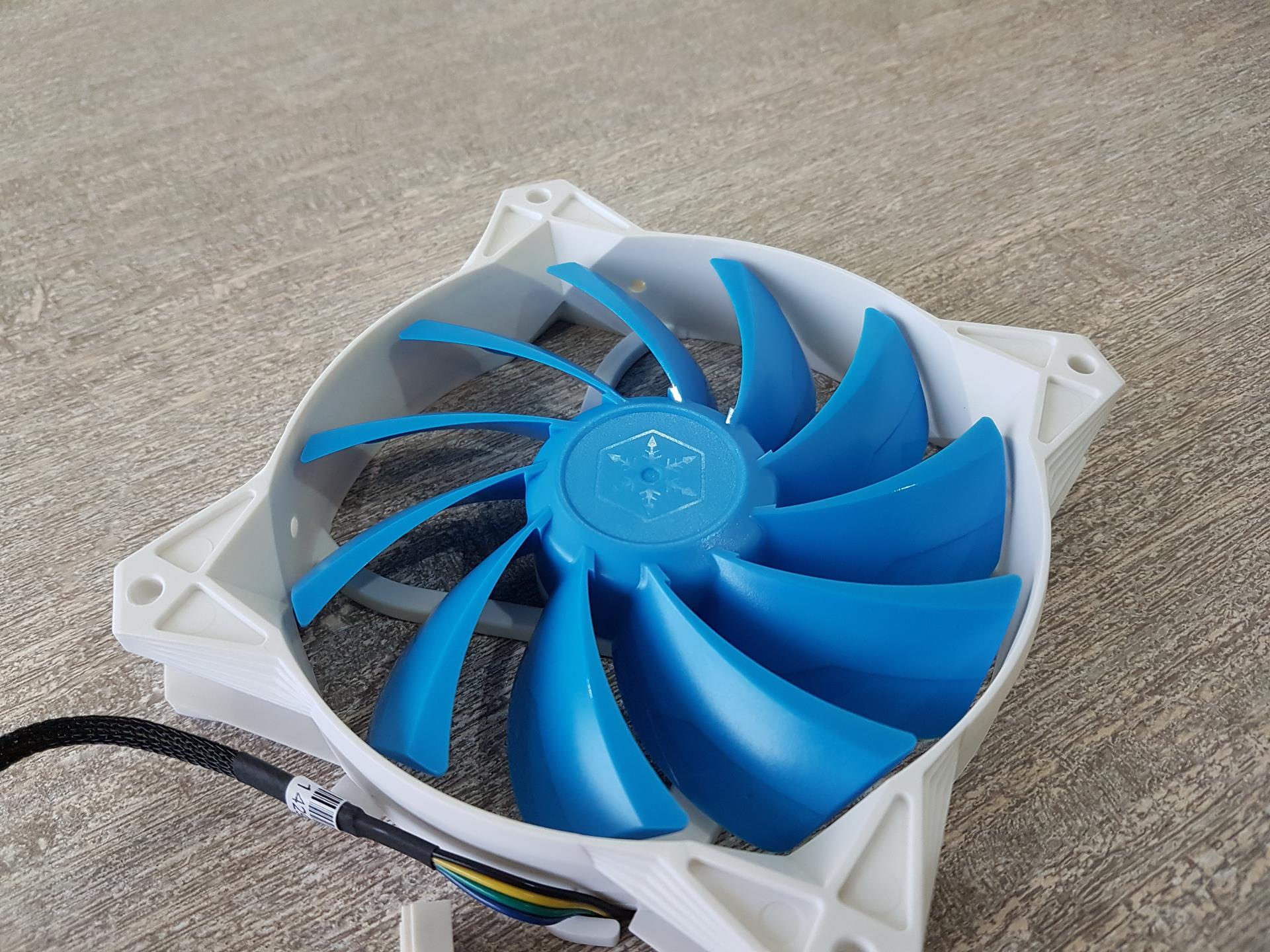
Radiator Cooling Performance – What size is best?
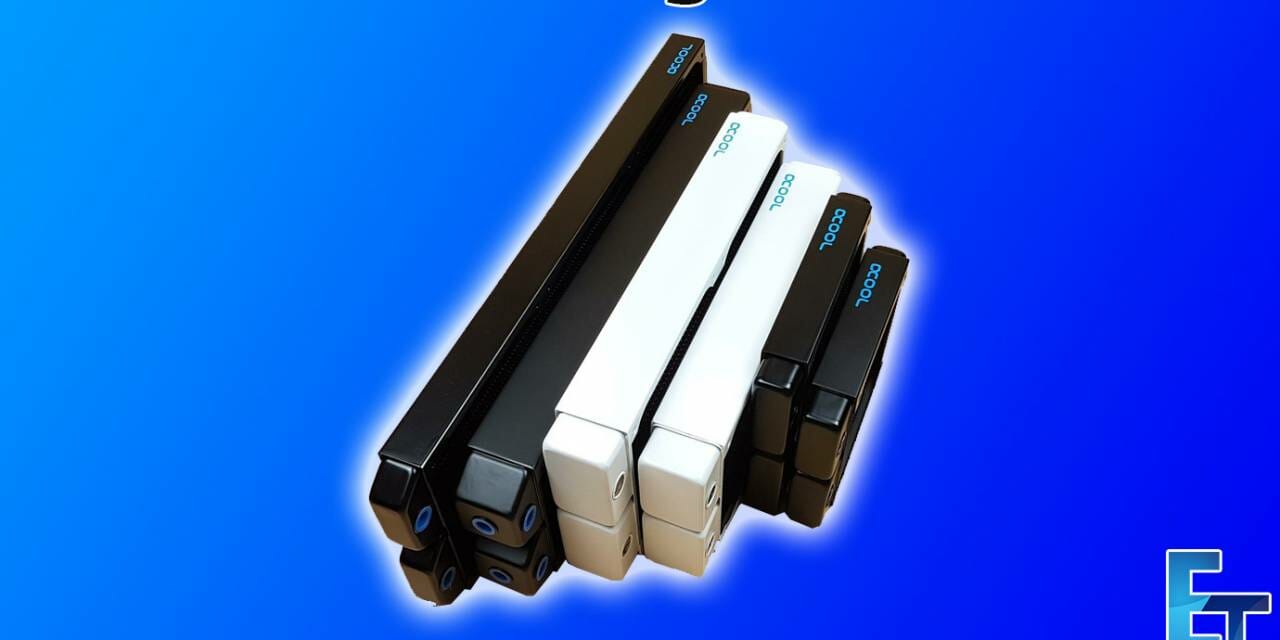
Introduction
Alphacool has a variety of radiators in the NexXxoS series. They cover enterprise-grade solutions including server cooling as well as consumer-grade solutions. For that, they have provided radiators in different sizes and materials which would cater to the requirement at hand. Radiators are also called heat exchangers as they have the critical role of exhausting the heat out of the loop. The warm coolant flows from the heat source and enters the radiator where it travels across the channels to the other side of the radiator and travels back to the outlet port of the radiator. These channels are interconnected using the fin stack. The heat is transferred to these fins and finally, the fans blow the hot air out of the radiator to cool the coolant. Hence the term exchanger.
Radiators are usually specified in terms of fan mounts or multiples of them. For instance, a 360mm radiator would mean (120mm x 3) that the radiator has 120mm fan mounts and the user can install up to 3x or 6x (push and pull) 120mm fans on the radiator. Similarly, a 280mm radiator would mean the 140mm fan mounts (140mm x 2) where a user can install 2x 140mm or 4x 140mm fans (push/pull) on the radiator. This is what we mean when we say the size of the radiator.
The radiators are made of aluminum or copper material. Copper has high heat conductivity rating than aluminum. This is the core reason, Alphacool focuses on using copper in the radiator. The channels and the fins are made of copper material whereas the bulkheads are made of bronze and the housing of the radiator is made of any other solid material. The majority of the Alphacool’s copper-made radiators have a slight black color coating on the fins’ top while we can still see the copper shimmer on the fin assembly.
The radiator has a minimum of 2x ports using G1/4” threads. One port acts as Inlet whereas the other port acts as an Outlet. There are no dedicated inlet/outlet ports unless specified and the user has to decide the port’s functionality as per the loop configuration and aesthetics. The V2 series of the NexXxoS radiators are now with flushed ports meaning the port is inset in the housing of the radiator and that the cover plug sits inside the port which is an effective design compared to the previous version of the radiator where the plugs would sit on top of the port and hinders the convenient installation of the radiator in the PC case. Some radiators have as many as 6x ports on the near head and some also feature a drain port on the far head.
Another important characteristic of the radiator is the fins count mentioned as FPI which stands for Fins Per Inch. This variable is important when selecting the fans for the radiators. If the radiator has a high fin count, it would imply a dense fin stack for which the high static pressure fan would be needed. If the fin count is low then we don’t have a dense fin stack and a standard static pressure fan can be mounted.
The FPI is also related to the thickness of the radiator which is another critical variable for the selection of the right fans for the radiators. Usually, the radiators have a thickness of 30mm. But we have seen radiators of up to 60mm thickness. The fan selection would differ for thicker rad over the thinner rad and the user should also keep in mind the FPI count along with the thickness.
Lastly, there is a pressure bar rating of the radiator usually specified as 1 bar or 2 bar and so on. If you are using the leak tester on the loop, keep in mind the pressure ratings of individual components in the loop to avoid damaging them. The optimal design of the radiator would restrict the coolant flow from none to minimal.
So, what better does a radiator of 360mm size than the one with 240mm size? This is the topic we are covering in this content. The custom cooling or open loop cooling facilitates:
- High overclocking
- Low Noise Output
Please note that we are not discussing the fitment of the radiators in the PC Cases in this content. Clearance and compatibility are best discussed during the individual contents of the PC Cases. With radiators, we have a term surface area. The more the size of the radiator, the more surface area and volume we would have in the loop. With more surface area, we can afford to lower the speed of the fans to achieve the best noise-to-performance ratio without compromising the overall thermal performance of the loop though this is subjective to the FPI count and the thickness of the fin assembly. Similarly, having more surface area would allow us to push our CPU and graphics cards to the very limit of the silicon itself and achieve the best out of these chips while taming the temperatures better than the traditional cooling solutions like air cooling or AIO cooling.
We were pitched an idea to test the various sizes of radiators and see the thermal performance across those sizes. We spotted this opportunity with the latest shipment from Alphacool for review and set up a standard loop to test the thermal performance using different size radiators. We have tested the following radiators:
- Alphacool NexXxoS Full Copper ST30 120 V2
- Alphacool NexXxoS Full Copper XT45 120
- Alphacool NexXxoS Full Copper ST30 140 V2
- Alphacool NexXxoS Full Copper XT45 240 V2 White
- Alphacool NexXxoS Full Copper XT45 280 V2 White
- Alphacool NexXxoS Full Copper XT45 360
- Alphacool NexXxoS Full Copper ST30 420
In terms of size we are covering:
- 120mm
- 140mm
- 240mm
- 280mm
- 360mm
- 420mm
Let’s take a look at the comparative statement of these radiators.

Packaging and Unboxing
Before we plunge into the testing section, let’s take a look at the packing of the radiator and box contents. We will cover one radiator in this section as more or less the layout and contents are identical subject to the size of the radiator.
We are showing the Alphacool NexXxoS Full Copper XT45 360 radiator here. Though the packing seems to be the V2 the radiator itself does not seem to be the V2 version.
The radiator is placed inside a bubble sheet and is tucked between the white color Styrofoam pads. There is a black color box having the mounting hardware.
We have:
- 12x M3x35mm screws
- 12x M3x30mm screws
- 12x M3 screws
- 1x Allen Key
30mm screws are to be used use for regular fan mounting on the radiator.
Closer Look
Let’s take a look at each radiator first.
The NexXxoS Full Copper ST30 120 V2 is the full name of the 120mm size radiator having a thickness of 30mm. the tank heads are not protruding the overall height of the radiator housing and we have flushed fittings and ports on the radiator. The radiator also has one drain port on the far head.
The NexXxoS Full Copper ST30 140 V2 is a 140mm size radiator having 30mm thickness. Except for the dimension, it is identical to the 120mm version.
The NexXxoS Full Copper XT45 240 and 280 are special white editions in the V2 series of radiators from Alphacool. Both radiators have a white color frame that is powder-coated. The fins and channels are not in the white color coating. We still have the black and shimmering copper on the fin assembly. Each radiator has a 4x G1/4” threaded port and both have a drain port as well.
The NexXxoS Full Copper ST30 420 is a 420mm radiator having a thickness of 30mm. It is a slim design and can house 3-6 140mm fans. Despite the 30mm slim thickness, the radiator has a high-density fins design. The FPI is 16. The radiator has only 2x G1/4” threaded ports and there is no drain port.
The NexXxoS Full Copper XT45 360 is a 360mm size radiator having a thickness of 45mm. It has a less dense fin stack as compared to the 420mm slim radiator. This radiator does not seem to be V2 series as it does not have flush fittings and ports. This radiator has 6xG1/4” threaded ports on the bulkheads. There is a drain port on the far head. The radiator can house 3-6 120mm fans.
The 360mm radiator has black color steel-made housing with Alphacool branding on the side. All the radiators in this study are from Alphacool and they all bear the same layout.
The above picture shows a drain port on the 360mm radiator, located on the far head. All radiators except the 420mm one have a drain port.
The above picture shows 4x G1/4” threaded ports on the 360mm radiator. There are two more such ports on the backside of the bulkhead making the total count to 6. The 420mm radiator has only 2x such ports whereas the 120mm ST30, 140mm ST30, 240mm XT45, and 280mm XT45 have 4x such ports. The 120mm XT45 was taken from the Eisblock GPX for GTX 1080 which we have reviewed earlier. Click here to check that content.
Behold the stack of Alphacool radiators.
The above picture better shows the length and the thickness of these radiators.
Test Loop Configuration and setup
Testing multiple radiators for their thermal performance is quite a hectic undertaking. We wanted to set up a loop that would require minimum handling when swapping the radiator without draining the other components of the loop. This was achieved using two Quick Disconnect fittings from Alphacool and they were connected to IN and OUT ports on the radiator. This was we were able to disconnect the entire radiator from the loop without draining the loop and dis-assembling/assembling it over and over again.
CPU Water Block
We have used Alphacool Eisblock XPX AURORA Edge digital-RGB water block. You can check it out in the dedicated content by clicking here.
Reservoir/Pump
We have used the Alphacool Eisbecher D5 which is a reservoir and pump combo unit comprising the Alphacool VPP755 PWM pump and 250mm Plexiglass tube. You can check it out in the dedicated content by clicking here.
Tube
We have used Alphacool AlphaTube HF clear tube 16/10mm size. The tubes have a blue tint to them.
Fittings
We have used Alphacool HF compression fittings of size 16/10mm.
We requested 6 fittings packs which come in a nice presentation.
Take a look at the fittings.
We have also used 16/10 90° adapters.
Fans
Fans are quite a question mark with regard to which set of fans to use for this testing and whatnot. We decided to use the powerful fans available from none other but Noctua so that we can be certain that fans are not the weaklings in the entire loop and that we would get the true picture of the radiators’ performance. For that, we picked Noctua NF-F12 iPPC-3000 PWM and NF-F14 iPPC-3000 PWM fans. These fans are industrial-grade fans with high static pressure and airflow ratings. Yes, they also produce a ton of noise so we have also tested using noise normalized operations.
Salient specifications of the fans are:
| Dimension | 120x120x25mm | 14x140x25mm |
| Speed | 3000 RPM (±10%) | 3000 RPM (±10%) |
| Airflow | 186.7 m³/h | 269.3 m³/h |
| Noise | 43.5 dB(A) | 41.3 dB(A) |
| Static Pressure | 7.63 mmH₂O | 6.58 mmH₂O |
| Input Power | 3.6 W | 6.6 W |
| Input Current | 0.3 A | 0.55 A |
| Operating Voltage | 12 V | 12 V |
| MTTF | > 150,000 MTTF | > 150,000 MTTF |
The above is a picture of the Eisblock XPX AURORA Edge installed on the motherboard.
The above picture shows the assembled loop inside the Thermaltake Core P6 TG Snow Edition which is converted into an open frame style.
Thermal Testing
Following test configuration is used: –
- Intel i7 10700k
- MSI MAG Z490 TOMAHAWK
- T-Force NightHawk RGB 16GB @ 3200MHz
- Nvidia GeForce GTX 1080 FE
- addlink S70 256GB NVMe SSD
- bequiet! Straight Power 11 850W Platinum PSU
- Thermaltake Core P6 TG Snow Edition converted into an open-frame layout
Here is the settings table for testing:
| Clock (MHz) | 3800 All Cores |
| Voltage (V) | 1.043V |
| Clock (MHz) | 5000 All Cores |
| Voltage (V) | 1.324 |
| Turbo Boost | Disabled |
| C-States | Disabled |
| Speed Step | Disabled |
| Thermal Paste | Noctua NT-H1 |
| Thermal Paste Application | Dot Method in the center. |
| Test Run Time | 60 minutes |
| Idling Time | 10 minutes |
| Fan Speed | 100% PWM Duty Cycle |
| Pump Speed | Full speed through Molex connector |
| Header | CPU_Fan header for the fans |
| Software | AIDA64 6.3 Extreme [FPU] |
We have used the Noctua NT-H1 for this testing with fresh application on the radiator swap. We have included the 3.8GHz all cores testing as well to establish a baseline for comparison. The ambient temperature was in the range of 15°C to 19°C. Since the variation in the ambient temperature was above 1°C, we have reported delta temperatures in the graph. The testing is done on an open-air bench system. Once inside the chassis, the temperatures are expected to rise and would largely depend upon the optimal airflow inside the chassis.
Let’s take a look at the results.
3.8GHz All Cores
Surprised! The Alphacool NexXxoS XT45 360 is on the top with a 0.6°C margin with the NexXxoS ST30 420mm radiator. The 45mm thickness is playing its role with this marginal performance difference between the 420mm and 360mm radiator.
5.0GHz All Cores
The CPU was pulling roughly 180W as reported by the AIDA64 Sensor log whereas the PMD indicates the 210W pull in real-time. This time we have the NexXxos Full Copper ST30 420 on the top though both 360mm and 420mm radiators were found to be neck-to-neck as this is a marginal lead. The 280mm radiator surprised me as it was sitting closer to the 240mm in the graph. The temperature was in the 80s using the 120mm and 140mm radiators. This level of performance is not expected from the 120mm or 140mm AIO coolers. Only the custom loop cooling solution is adequate to handle the heat output even with less surface area.
Noise Normalized Performance
The Noctua iPPC fans were producing roughly 74 dB(A) noise output at full speed. The noise was normalized at 48 ~ 49dB(A) for which the 120mm fans were set at 45% PWM duty cycle and 140mm fans were set at 42% PWM duty cycle. The speed was in the 1400~1429 RPM as compared to 2978 and 2910 RPM for 120mm and 140mm fans respectively at full speed. Here are the results:
The 360mm and 420mm radiators were again found neck-to-neck. The 280mm was again sitting closer to the 240mm performance level. The thermals with the 120mm and 140mm fans spiked but still remain within the thermal limit of the CPU and this has surprised us. We were not expecting the 120mm radiator to withstand the thermal heat but it did well. So was the case with the 140mm radiator.
Conclusion
We are working on an idea about measuring the thermal performance using various size radiators. We took the opportunity with the new review units from Alphacool and started this project. The radiator in the loop is as important a component as the water block and the pump. The radiator is also called a heat exchanger as it is the very component in conjunction with the fans responsible to take the heat out of the loop.
We have mentioned above that radiators come in multiple sizes and thicknesses. The size is mentioned in terms of the fan mounts or sometimes in the terminology of double, triple like 240mm radiator would mean the radiator can house a minimum of 2x 120mm fans and maximum of 4x 120mm fans. Similarly, a 360mm fan could mean a triple 120mm or dual 180mm. Hence the length and thickness of the radiator are two important factors. Then comes the surface area or the volume of the radiator. The fins count is mentioned as FPI (Fins per Inch). The higher this count, the more dense the radiator is and we would need high static pressure fans for effective airflow through the radiator. Then we have the pressure rating of the radiator expressed in Bar.
We have used the following radiators in this study:
- Alphacool NexXxoS Full Copper ST30 120 V2
- Alphacool NexXxoS Full Copper XT45 120
- Alphacool NexXxoS Full Copper ST30 140 V2
- Alphacool NexXxoS Full Copper XT45 240 V2 White
- Alphacool NexXxoS Full Copper XT45 280 V2 White
- Alphacool NexXxoS Full Copper XT45 360
- Alphacool NexXxoS Full Copper ST30 420
The 45mm thick 120mm radiator was taken from the Eisblock GPX cooler for the GTX 1080. It is not an easy undertaking since we have to swap the radiator after the completion of the testing. We set up the loop such as the IN and OUT ports on the radiator were connected with the quick disconnects. That way, we were able to save time as the complete loop will remain intact and we were able to swap the radiator easily. The only thing that was needed was to fill the reservoir with the coolant after every swap.
The following components were used to set up the loop:
- Alphacool Eisblock XPX AURORA EDGE digital RGB block
- Alphacool Eisbecher D5
- Alphacool HF 16/10mm Compression fittings
- Alphacool HF 16/10mm 90° adapters
- Alphacool Quick-Disconnect Fittings
- Alphacool Clear Tube 16/10mm
The most important component was the fan. Since we have different thicknesses and different FPI count radiators, we wanted to use the powerful fans to ensure that they would not be the bottleneck source anyway. That is why we ended up using the Noctua NF-F12 iPPC-3000 PWM and NF-F14 iPPC-3000 PWM fans for this testing. These are among the powerful fans in the market having 7.63 mmH₂O and 6.58 mmH₂O static pressure ratings for the 120mm and 140mm fans respectively. The airflow rating of 120mm fan is 186.7 m³/h [109.9 CFM] and that of 140mm is 269.3 m³/h [158.6 CFM]. Since the other components of the loop i.e the water block and the pump/reservoir combo remain the same, the only difference would be coming straight from the radiator itself as the same margin of error applies to all.
We have tested the Intel i7 10700k at 5.0GHz all cores under the synthetic stress test load using AIDA64 Extreme [FPU]. The Alphacool NexXxoS Full Copper XT45 360 and ST30 420 were found performing almost at par even under the noise normalized testing. Clearly, the thickness of the radiator with FPI count is kicking in and playing a role. The 280mm 45mm thick radiator was closer to the 45mm thick 240mm radiator. The 120mm 45mm thick rad offers better performance than its counterpart in 30mm thickness.
There is no conclusion here since the study aims at measuring the thermal performance of the radiators using the same loop configuration and under the same given thermal load. This would give a certain bit of an idea to the readers as to what to expect from the given size/thickness radiator though the selection of components would affect the equation.
Though we would like to highlight that this is not a conclusive study either because we would want to use the same thickness radiators for better understanding i.e all radiators in say 30mm thickness. Then we would like to take this study to the next level by repeating the tests with 45mm thick radiators and so on. Then we will have conclusive results given the thickness category of the radiators.
We are hoping that Alphacool would send us more radiators so that we can continue testing the radiators and update the results of this content subsequently.
















